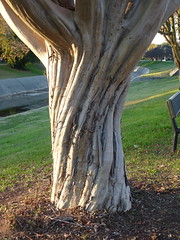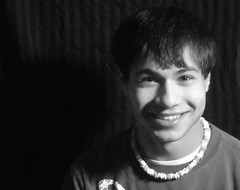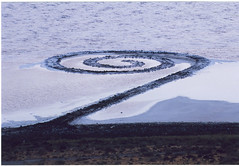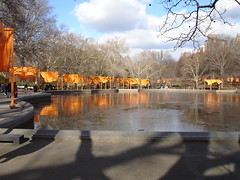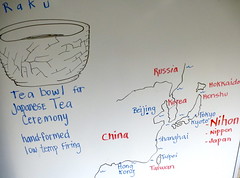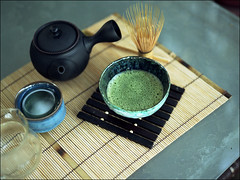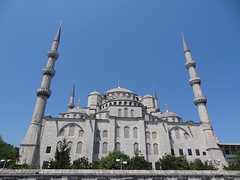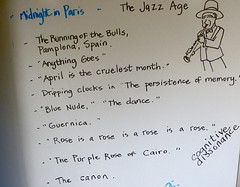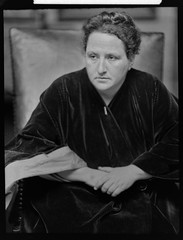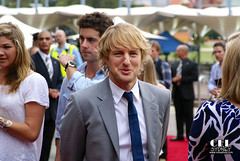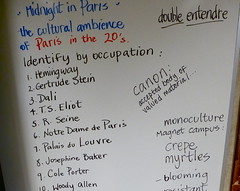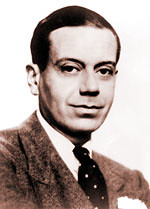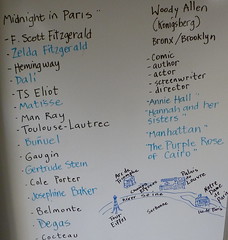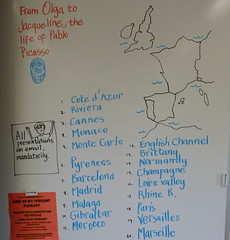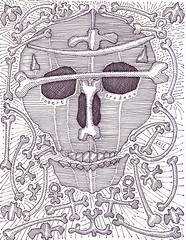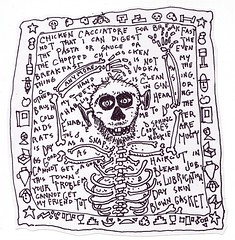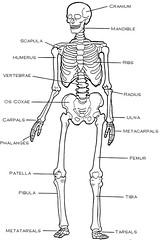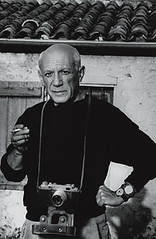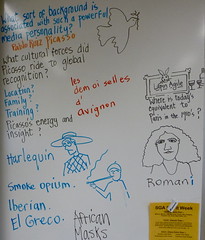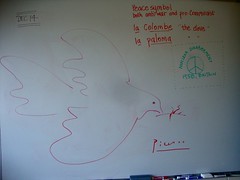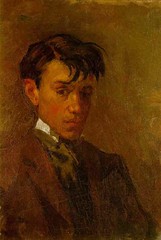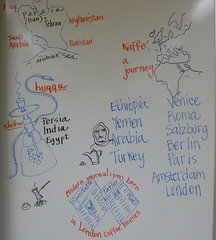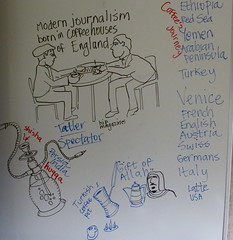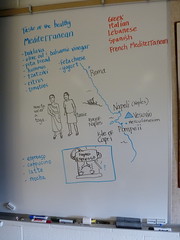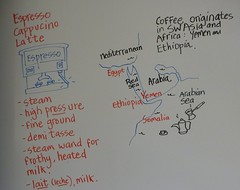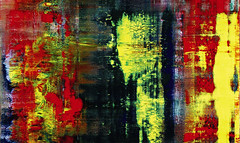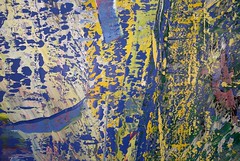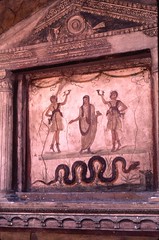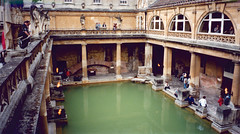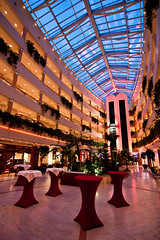Photography
1. Chiaroscuro: a) painter's rich coloration b) deep light and dark areas in an image c) dramatic portraiture d) side lighted image.
2. Developed an early form of photo on paper that he termed the
Callotype. a) Louis Daguerre b) William Henry Fox Talbot c)
Nicephore Niepce d) Auguste Lumiere.
3. Earliest of French pioneers in photography. a) Louis Daguerre b)
William Henry Fox Talbot c) Nicephore Niepce d) Auguste Lumiere.
4. British pioneer in photography. a) Louis Daguerre b) William Henry
Fox Talbot c) Nicephore Niepce d) Auguste Lumiere.
5. US Civil war photographer Matthew Brady used the type of
metal-plate photo developed by this French inventor. a) Louis Daguerre
b) William Henry Fox Talbot c) Nicephore Niepce d) Auguste Lumiere.
11. Camera obscura: the word "obscura" refers to a) dark b) pin hole aperture c) using natural light d) a historic item.
12. Rembrandt lighting begins with side lighting but locates the light
source ahead of and slightly __ the subject. a) above b) below c)
behind d) aside.
13. Photography has its roots in a pre-film device called a __ __ . Literally, the term means "room," "dark." Visual artists used the tool for centuries before it was used in photography.
14. Literally, "writing" with "light:" __ .
Thursday, December 13, 2012
Thursday, December 6, 2012
Camera Obscura
The camera obscura (Latin; camera for "vaulted chamber/room", obscura for "dark", together "darkened chamber/room"; plural: camera obscuras or camerae obscurae) is an optical device that projects an image of its surroundings on a screen, says Wikipedia.
It is used in drawing and for entertainment, and was one of the inventions that led to photography and the camera. The device consists of a box or room with a hole in one side. Light from an external scene passes through the hole and strikes a surface inside where it is reproduced, upside-down, but with color and perspective preserved. The image can be projected onto paper, and can then be traced to produce a highly accurate representation.
It is used in drawing and for entertainment, and was one of the inventions that led to photography and the camera. The device consists of a box or room with a hole in one side. Light from an external scene passes through the hole and strikes a surface inside where it is reproduced, upside-down, but with color and perspective preserved. The image can be projected onto paper, and can then be traced to produce a highly accurate representation.
Wednesday, December 5, 2012
Photography assignment: 3 black and white portraits using side or Rembrandt lighting; due 12.12.12
- Shoot and place online 3 portraits featuring side lighting. Convert the images to black & white in your computer.
- Standards: sharp focus, plain & dark background, adequate lighting and contrast.
- Option: print on typing paper and frame via cardboard mats as found in crafts stores such as Michaels, Hobby Lobby. Please use 5X7 or 8X10.
- One portrait pose should be an imitation of a famous Rembrandt painting.
Be prepared to write an in-class essay on the process and outcome of your project.
- What you did; what you learned.
- Offer both description and insight.
‘Rembrandt’ or ‘chiaroscuro’ lighting accentuates the focal point of the composition by bathing it in light and surrounding the focal point by darker recesses, says David Bennett.
The Italian word ‘chiaroscuro’ means light and dark, and the alternative name of ‘Rembrandt’ lighting comes from the fact that he created that lighting effect in a lot of his paintings and may be the finest artist to have used the technique.
The contrast between light and dark areas also accentuates the three-dimensional appearance of the subject.
Your main source of light is about 45 degrees to the right of center - and Slightly Above your subject.
The key to Rembrandt style is to have the shadow created by the nose connect with the shadow on the far side of the face - creating a triangular highlight on the subject’s cheek.
Read a basic bio of Rembrandt van Rijn.
- Standards: sharp focus, plain & dark background, adequate lighting and contrast.
- Option: print on typing paper and frame via cardboard mats as found in crafts stores such as Michaels, Hobby Lobby. Please use 5X7 or 8X10.
- One portrait pose should be an imitation of a famous Rembrandt painting.
Be prepared to write an in-class essay on the process and outcome of your project.
- What you did; what you learned.
- Offer both description and insight.
‘Rembrandt’ or ‘chiaroscuro’ lighting accentuates the focal point of the composition by bathing it in light and surrounding the focal point by darker recesses, says David Bennett.
The Italian word ‘chiaroscuro’ means light and dark, and the alternative name of ‘Rembrandt’ lighting comes from the fact that he created that lighting effect in a lot of his paintings and may be the finest artist to have used the technique.
The contrast between light and dark areas also accentuates the three-dimensional appearance of the subject.
Your main source of light is about 45 degrees to the right of center - and Slightly Above your subject.
The key to Rembrandt style is to have the shadow created by the nose connect with the shadow on the far side of the face - creating a triangular highlight on the subject’s cheek.
Read a basic bio of Rembrandt van Rijn.
Sunday, December 2, 2012
Christo & Jeanne Claude: across the globe on billowing fabric and anchored steel
While he has been based in NYC for decades, Christo is a native of Bulgaria, Eastern Europe.
Jeanne Claude, native of France, was both his wife and partner in the art projects.
In Australia, 1969, they wrapped synthetic fabric over 1.6 miles of the coast near Sydney, Australia. It was the largest single artwork ever.
Valley Curtain was produced in 1971. Fabric was stretched across Rifle Gap, a valley in the Rocky Mountains of Colorado.
The cloth was hung on four steel cables, fastened with iron bars fixed in concrete on each slope held by 200 tons of concrete. There were 2 installations of fabric; high winds soon destroyed each fabric span.
Running Fence (1972 - 1976) was an 18' high fabric fence of 250 miles length supported by steel posts and steel cables running through the landscape and leading into the sea. It was constructed in Sonoma and Marin Counties, California.
With "Wrapped Walk Ways" (1977) Christo and Jeanne-Claude covered 4.5 km of footpaths in Loose Park, a park in Kansas City, Missouri. Pedestrians enjoyed the artwork for two weeks in October.
Surrounded Islands (1983): eleven islands in Miami's Biscayne Bay were encircled in pink polypropylene floating fabric for 2 weeks.
In 1984 they wrapped the Pont-Neuf, a historic bridge in Paris, after nine years of negotiations with the mayor of Paris. In the two week display over three million people visited the work.
The Umbrellas (1984 - 1991), a temporary work of art realized in two countries at the same time, reflected the similarities and differences in the ways of life and the use of the land in two inland valleys in Japan and the USA. There were 1,340 blue umbrellas in Ibaraki and 1,760 yellow umbrellas at the Tejon Ranch in southern California.
One of the umbrellas in California was toppled by high winds, killing one woman and injuring several others. The exhibit was ordered closed immediately.[11] A second death occurred during the removal of the umbrellas.
Permission from 662 delegates, a 70- minute debate in Parliament and a Roll Call vote was involved in getting the Bundestag project OK in 1995 for Wrapping the Reichstag.
After 32 years of negotiation Christo and Jeanne-Claude wrapped 178 trees in Berower Park, north-east of Basel, Switzerland. The form-fitted silver fabric fabric remained almost a month in 1998 before being removed and recycled.
"The Gates, Central Park, New York, 1979-2005" referred to the time that passed from their initial proposal until they were able to get permission of the mayor of New York for a 2-week installation of steel gates and fabric in Central Park.
Over The River, is to be constructed on the Arkansas River between Salida, Colorado and Cañon City, Colorado on the eastern slope of the Rocky mountains. This scenic area is known as Bighorn Sheep Canyon, and is west of the well-known Royal Gorge.
Plans for the project call for horizontally suspending 6.7 miles of reflective, translucent fabric panels high above the water, on steel cables anchored into the river's banks. The project is planned for two weeks in the summer of 2015.
The projects have been financed by selling studies, drawings, collages and works. They have avoided sponsorships. Additional money has been raised from the sale of souvenirs such as postcards, t-shirts and posters.
Projects:
- Map and briefly describe their major works.
- List the pros and cons of their work.
- Compare to the work of Pablo Picasso. Brief essay summarizing their place in history.
Jeanne Claude, native of France, was both his wife and partner in the art projects.
In Australia, 1969, they wrapped synthetic fabric over 1.6 miles of the coast near Sydney, Australia. It was the largest single artwork ever.
Valley Curtain was produced in 1971. Fabric was stretched across Rifle Gap, a valley in the Rocky Mountains of Colorado.
The cloth was hung on four steel cables, fastened with iron bars fixed in concrete on each slope held by 200 tons of concrete. There were 2 installations of fabric; high winds soon destroyed each fabric span.
Running Fence (1972 - 1976) was an 18' high fabric fence of 250 miles length supported by steel posts and steel cables running through the landscape and leading into the sea. It was constructed in Sonoma and Marin Counties, California.
With "Wrapped Walk Ways" (1977) Christo and Jeanne-Claude covered 4.5 km of footpaths in Loose Park, a park in Kansas City, Missouri. Pedestrians enjoyed the artwork for two weeks in October.
Surrounded Islands (1983): eleven islands in Miami's Biscayne Bay were encircled in pink polypropylene floating fabric for 2 weeks.
In 1984 they wrapped the Pont-Neuf, a historic bridge in Paris, after nine years of negotiations with the mayor of Paris. In the two week display over three million people visited the work.
The Umbrellas (1984 - 1991), a temporary work of art realized in two countries at the same time, reflected the similarities and differences in the ways of life and the use of the land in two inland valleys in Japan and the USA. There were 1,340 blue umbrellas in Ibaraki and 1,760 yellow umbrellas at the Tejon Ranch in southern California.
One of the umbrellas in California was toppled by high winds, killing one woman and injuring several others. The exhibit was ordered closed immediately.[11] A second death occurred during the removal of the umbrellas.
Permission from 662 delegates, a 70- minute debate in Parliament and a Roll Call vote was involved in getting the Bundestag project OK in 1995 for Wrapping the Reichstag.
After 32 years of negotiation Christo and Jeanne-Claude wrapped 178 trees in Berower Park, north-east of Basel, Switzerland. The form-fitted silver fabric fabric remained almost a month in 1998 before being removed and recycled.
"The Gates, Central Park, New York, 1979-2005" referred to the time that passed from their initial proposal until they were able to get permission of the mayor of New York for a 2-week installation of steel gates and fabric in Central Park.
Over The River, is to be constructed on the Arkansas River between Salida, Colorado and Cañon City, Colorado on the eastern slope of the Rocky mountains. This scenic area is known as Bighorn Sheep Canyon, and is west of the well-known Royal Gorge.
Plans for the project call for horizontally suspending 6.7 miles of reflective, translucent fabric panels high above the water, on steel cables anchored into the river's banks. The project is planned for two weeks in the summer of 2015.
The projects have been financed by selling studies, drawings, collages and works. They have avoided sponsorships. Additional money has been raised from the sale of souvenirs such as postcards, t-shirts and posters.
Projects:
- Map and briefly describe their major works.
- List the pros and cons of their work.
- Compare to the work of Pablo Picasso. Brief essay summarizing their place in history.
Thursday, November 29, 2012
FAS semester exam guide, 12.19.12
The FAS semester exam will comprise
a) 50 multiple-choice questions taken from quizzes posted on the class blog. An open-notes test, some of the questions will have been tweaked to add an element of rigor to this test of reading comprehension.
Answered and scored on Scantron forms.
b) Brief comparison essay of any two not-ordinarily-relatable topics. Examples:
- Basquiat and Bas relief sculpture.
- Espresso and the Pantheon.
- Greek alphabet and Diego Rivera.
- Frida Kahlo and the Parthenon.
If you have a comparison essay question, ask my approval during class - write it in your notebook and I will initial it - or via email.
The rubric (required elements) that will guide essay writing:
1. Colorful opening. There are 3 recommended ways to create an interest-getting opening: a) use a quote b) ask a question c) write with vivid description.
2. Blend the topics continually in the paper. Do not write a block of material about one topic and then write a separate block about the other topic. Integrate the topics as you offer insight and evidence.
3) Use comparison terms:
* different from,
* the same,
* both,
* similar to,
* Neither, ... nor,
* like X is (adjective),
* ... than X is (adverb) than.
* both, ...
* either...or
* likewise
* similarly
* although,
* but neither...
* nor
* however
* on the other hand
4. Specific examples must be used to support generalities. An example: generality - The Incredibles was an awesome movie. specific - The Incredibles appealed to me because the characters (especially the mom and the teen sister) were believeable. They sounded like people I know.
5. Grammar counts.
6. Spelling, too. When in doubt, see a dictionary or ask me.
7. Punctuation is paramount. Again, ask me or your Grammar Check software.
8. Include documentation via "according to ...". This means include your source - from World Book to your little brother - in the body of your writing. Usually you place it at the end of the first or second sentence, says Grammar For Today.
9. Write a snappy title. Ways to make a title fun are to tweak a song or movie title or use alliteration. Also, write an explanatory subtitle. Example: "Dinkas are Incredibles;" "Many refugees from the Sudanese Dinka tribe have moved from poverty in east Africa to comfort in the US."
Finally, please don't put quotation marks around your title - unless you are quoting someone.
Habanero and hola! quiz
1. The monumental art form created by indigenous peoples in Mexico: a) cities surrounded by water b) cities carved into rocky promontories c) pyramids.
2. Diego Rivera was a Mexican artist whose peak of fame was in the 1950's. He worked in buildings in the US, Europe and Mexico. His principal art format was probably the a) mural b) tapestry c) relief painting d) sculpture.
3. Name 2 indigenous (native) peoples of Mexico. a) Toltec b) Aryan c) Inca
d) Tartars e) Maya d) Hasinai.
4. Two food resources that originate in Mexico. a) chili peppers b) black pepper c) cacao bean d) vanilla bean e) sugar cane f) barley.
5. Mexico is surrounded by an ocean and 2 seas: __, __ _ ___, __ .
6. The capital city of Mexico: a) Guadalajara b) Monterrey c) Mexico, DF.
7. When you think of El Chicos and Trejo's the term "Mexican food" is not quite the most accurate designation. How should their cooking be classified?
8. Mexico-born and raised actress: a) Salma Hayek b) Annette Benning c) Cate Blanchett d) Meryl Streep.
1. pyramids in both the Yucatan Peninsula and central Mexico. 2. murals and frescoes.
3. Toltec, Aztec, Olmec, Maya. 4. chili pepper, cacao bean, vanilla bean.
5. Pacific, Gulf of Mexico, Caribbean. 6. Mexico, Distrito Federale. 7. Tex-Mex, a hybrid. 8. Salma Hayek.
Mandatory map of Mexico
1. Peninsula on the Pacific coast: __ __.
2. Resort at tip of peninsula on the Pacific / Gulf of California. __ _ __ .
3. Peninsula on the Gulf of Mexico / Caribbean. __
4. Resort island on the Caribbean coast: __ .
5. Resort on the Pacific mainland famous for cliff divers and honeymoon suites: __ .
6. Border town across from San Diego: __ .
7. Border town across from El Ppaso: __ __ .
8. Western mountain range: __ __ __ .
9. Eastern mtn. range __ __ __ .
10. Population of Mexico City: a) 5 M b) 10M c) 22M.
Manhattan's most famous sections. Commit to memory, please.
1. Center of jazz history and Afr-Amer culture: __ .
2. Notable institution in Morningside Heights and Harlem: ____ Univ.
3. Upper ___ Side (Madonna, John Lennon, other rich & powerfuls)
4. Upper ____ Side (more of the wealthy class)
5. Broadway theater district and Carnegie Hall are in __ .
6. Art, shopping, high-tech, gay life in a neighborhood above the Village: __ .
7. Oldest historic neighborhood; once cheap housing for bohemians, today gentrified: __ __ .
8. Hip downtown music & art scene - "Rent" was set here: __ __ .
9. Center for impoverished immigrants (once dminated by Jews); today undergoing gentrification: __ __ __ .
10. Historic art, shopping, restaurants South of Houston St: __ . Think London.
11. Chinese immigrants' shops and restaurants in lower Manhattan: __ .
12. Fashionable historic warehouse district in a "Triangle below Canal St:" __ .
13. Lower Manhattan: __ __ financial district and site of the __ __ __ from 1973 to 2001.
14. River on the east side of Manhattan Is: __ River.
15. River on the west side of Manhattan Is: __ River.
16. Borough directly east of Lower Manhattan: __ .
17. Borough on the mainland north of Manhattan: the __ .
18. State west of NYC and south of NY state: __ .
19. State on Long Island Sound, northeast of NY and NYC : __ .
20. Process of refurbushing and upgrading old and run-down buidings and neighborhoods: ___ .
21. Harlem's classification: a) neighborhood b) borough.
1. Basquiat lived about __ years.
2. As a graffiti artist, Basquiat / SAMO focused on __ rather than stylishly painted logos.
3. As a developing artist, Basquiat lived in Manhattan on the __ __ __, a neighborhood where impoverished creative types flourished in the late 70's and 80's.
4. Oldest historic residential area of Manhattan.
5. Residences of the moguls in Manhattan.
6. Section of Manhattan where you'll find Carnegie Hall and the Plaza Hotel.
7. University adjacent to Greenwich Village
8. Process of upgrading old and run-down buidings and neighborhoods.
9. Most southerly borough of NYC.
10. Famous Manhattan neighborhood adjacent to the Bronx.
11. Peninsula on the Gulf of Mexico / Caribbean
The East Village quiz
1. In his art, it is said that Basquiat used "appropriation." Another word for appropriation would be a) stealing b) inspiration c) raunchiness d) bold color.
2. Basquiat was amoral and ahistorical, being a superbly contemporary thinker. T / F
3. "Genius Child" is a poem by a) Maya Angelou b) Lorraine Hansberry c) Zora Neal Hurston d) Langston Hughes.
4. The med school classic, Gray's Anatomy, has origins in 19th century a) Germany b) England c) America d) France.
5. In 1981 Basquiat painted one of his most-analyzed works, "Irony of Negro __."
6. Basquiat spoke Creole, among several languages, because his father was from the impoverished Caribbean island of __ .
7. Word that means not transparent or translucent: __ .
8. Word that means to provoke, to interest, to prick: to __ .
Sculpture quiz
1. Sculpture that is attached to the background but raised above the background in a moderate way has a name that includes a French term: __ __ .
2. "For sculpting you may bring a __, aka a writing utensil, a small tool for marking or shaping, for example in pottery." Think of a Latin word for a writing pen.
3. The Venus of Willendorf: found in 1908 in the nation of __ .
4. The Venus of Willendorf: was tinted the color __ .
5. Scholars feel that the name "Venus of Willendorf" is a) descriptive b) ethnocentric c) has widespread appeal d) evocative of classical history.
6. Statues, coins, drawings, pendants or rings carried on a person to repel evil: __ .
7. This revolutionary Pharaoh, today known as the father of Tutankhamun as well as husband of Nefertitti, radically changed Egyptian art, architecture and religion: __ . Spell the name correctly, please.
8. High above the city of Athens is a temple dedicated to a woman. What is the name of the elevated mesa upon which the temple stands? __ .
Historic sculpture quiz
1. Sculpture that is attached to the background but raised above the background in a moderate way has a name that includes a French term: __ __ .
2. "For sculpting you may bring a __, aka a writing utensil, a small tool for marking or shaping, for example in pottery." Think of a Latin word for a writing pen.
3. The Venus of Willendorf: found in 1908 in the nation of __ .
4. The Venus of Willendorf: was tinted the color __ .
5. Scholars feel that the name "Venus of Willendorf" is a) descriptive b) ethnocentric c) has widespread appeal d) evocative of classical history.
6. Statues, coins, drawings, pendants or rings carried on a person to repel evil: __ .
7. This revolutionary Pharaoh, today known as the father of Tutankhamun as well as husband of Nefertitti, radically changed Egyptian art and architecture: __ . Spelled correctly, please.
8. High above the city of Athens is a temple dedicated to a woman. What is the name of the elevated mesa upon which the temple stands? __ .
Parthenon:
- pediment
- bas relief sculpture
- doric columns
- capitals
- flutes
- statue of Athena
- frieze
- Greek key
- Bust of Pericles, 450 BCE
- Under the Parthenon add a representation of the acropolis.
Identify Espana, L'Italia, Graecia, Aegypticus, Maroc and Carthage.
Discovering Art History: pp 172 - 190.
1. The Cretan civilization is called the Minoan for their a) king b) queen c) soothsayer d) bull / king.
2. Early civilizations in the Aegean existed simultaneously with the Mesopotamian and Egyptian cultures. See chapter 5 to compare timelines. T / F
3. Mesopotamia ("land between the rivers") was today's a) Iran b) Iraq c) Saudi Arabia d) Lebanon.
4. Mycenae was, along with Olympia and Sparta, located on the Peloponnesus __.
a) island b) peninsula c) isthmus d) sea.
5. Minoan civilization was first known through Homer's a) Odyssey b) Iliad
c) Cyclops d) Trojan War.
6. A painting made of lines and colors applied to wet plaster is called a __ .
7. A study of the Palace of Minos at Knossos implies that Cretans were oriented toward a) trade b) war c) austerity.
8. Bull leaping can also be called bull- __. It's a word that refers to heights.
9. Sketch a representation of the a) Octopus jar and b) the Funeral mask. Label the cultures they represent.
Aegean quiz
1. The Peloponnesus has four notable locations: Corinth (and the Isthmus of Corinth), Olympia, Mycenaea and __.
2. The blind author whose focus was the Aegean: __ .
3. A __ is a type of painting made of lines and colors applied to wet plaster.
4. Bull vaulting is most famously associated with the nation of __ .
5. Simultaneity in the Mediterranean and Persian Gulf regions: Cretan, Mycenean, ____ and Egyptian cultures.
6. In the famous regional name which means "land between the rivers," which part of the name means "between"? __
7. The golden age of Crete is known as the __ civilization.
8. Typical of Mediterranean cultures, the Cretans reserved the rite of bull-vaulting for males. T / F 1. sparta 2. homer 3. fresco 4. crete 5. mesopotamian 6. meso 7. minoan 8. f
Greek alphabet
1. Looks like an upside-down V: __ .
2. A letter O with a horizontal bar in the center: __ .
3. The letter shape for Beta: __ .
4. The name for the empty O: __ .
5. The symbol for Pi: __ .
6. The unexpected symbol for Rho: __ .
7. First and last letters of the Gk alphabet: __ and __ .
8. Unexpected symbol for Eta: __ .
9. Sound that a cat utters: __ .
10. A hangman's frame: __ .
11. I'm za Sigma! __ .
12. Chi, pronounced Kye, has the shape of an __ .
13. The capital Y letter is an __ .
14. A capital I with "wings:" __ .
15. Three horizontal bars: __ .
16. "Oh, you're Nu here!" __ .
17. There's a tiny town in middle-of-nowhere Louisiana named Iota. __ .
18. I Eta Pi: __, __ .
19. Rock 'n roll is based largely on Delta blues. __ .
20. Taurus, the bull, shortened to T: __ .
21. Omicron my Gawd: __ .
22. It's raining. Put on your K: __ .
23. I got an advance look at that software; I'm a __ tester.
24. E! Magazine: __ .
25. National math honorary society, and active at Magnet: __ __ __ .
26. University-level honorary society that expects proof of consistently high ethics and grades to qualify: __ __ __ .
27. The lower-case version of this letter looks like a lower-case a: __ .
28. Third letter: __ .
29. The Epsilon was derived from Phoenician writing. T / F .
30. Symbol for the Earth. Also seen in the Celtic cross. Yet, sometimes a symbol for death: "thanatos." __ .
31. The lower-case fo0r this letter looks like a capital E in script: __ .
32. This Greek letter is rarely used in math, because it so ambiguous: __ .
33. Neptune and water; the S sound: __ .
34. A mathematical constant that is the ratio of a circle's circumference to its diameter: __ .
35. In math, art and literature, the Golden Ratio, or 1.61: __ .
36. The gigantic letter O: __ .
37. The tiny letter O: __ .
38. _ is often used to abbreviate the name Christ, as in the holiday Christmas.
39. The 14th of March (3.14. 2012) is widely celebrated as __ Day.
40. Used to refer to the lowest-ranked wolf in a pack or the least-powerful person in a group: __ .
41. X plus __ represents the person of Jesus Christ, or Chi Rho.
42. "Jeez, I wish that organization would name me as a pledge. Sigh!" __
43. The Black Gangster Disciple Nation, or the GD's, uses the trident symbol, or : __ .
44. In ancient times, __ was used as a symbol for life and/or resurrection. It is a form of the cross.
45. Cornell Univ, Ithaca, NY, was the site of the first black fraternity, Alpha Phi Alpha, 1906. Washington, DC's Howard University, 1912, was the site of the founding of the first black Greek sorority: __ __ __ .
Teotihuacan is the city of stone pyramids which is outside of today's Mexico City.
Attica is the region around Athens.
1. Stone pyramids were created by indigenous peoples in the Baja peninsula as well as the Yucatan Peninsula of Mexico. T / F False: there are none in the Baja.
2. The best-known of all Mexican artists is not Frida Kahlo. It is the muralist Diego Rivera.
3. Indigenous peoples of Mexico: the Olmecs, Toltecs, Aztecs and the _Mayans .
4. Black pepper, along with the vanilla bean and cacao bean, are foods that originate in Mexico. T / F False: Black pepper is from Asia. Chili peppers are Central American.
5. Mexico has a _Caribbean_ coastline as well as one on the Pacific and Gulf of Mexico.
6. Mexico's eastern mountain range: _Sierra Madre Oriental_ .
7. The most notable street in Lower Manhattan: _Wall_ .
8. Carnegie Hall and the Plaza Hotel are in _midtown_ Manhattan.
9. To the east of Columbia Univ is the borough called _the Bronx_ .
10. Impecunious Chinese, Jews and Italians historically settled in the _Lower East Side_ of Manhattan.
11. In his early career Basquiat was as much an aficionado of images, a designer, as a graffiti artist. False: he was a poet, not designer.
12. Part of Basquiat's success was due to his location: a) Manhattan b) Brooklyn c) Harlem d) SoHo. Born in B'lyn, he flourished in lower Manhattan, A).
13. If Basquiat had wanted to attend college, it would have been easiest for him to enroll at _NYU_. NYU is part of Lower Manhattan.
14. West of the Bronx is a famous Manhattan neighborhood called _Harlem_ .
15. Basquiat constantly used famous pieces of art as a basis for his paintings. That sort of taking of ideas is called _appropriation_ in the art world.
16. Basquiat loved a kind of jazz that was not popular in the 1980's: a) cool jazz b) bebop c) hip hop d) Dixieland. B) Dizzy Gillespie, etc; bebop.
17. Langston Hughes wrote a poem that seemed to apply very well to Basquiat. It is called " _Genius Child_ ."
18. As a child confined to a the hospital bed Basquiat's mother bought him a copy of a med school text: _Gray's Anatomy_ .
19. Basquiat spoke French, Spanish and _Creole_ , among several languages, because his father was from Haiti .
20. Opaque means not _translucent_ .
21. Incised sculpture is raised above the background to a moderate, not extreme, height. T / False: incised means "cut into."
22. Austria has a small town famous for a sculpture that has been given the Roman title of a __ . Roman title: a Venus.
23. Lockets or other small objects meant to insure safety: __ . amulets or talismans.
24. Akhenaten upset Egyptian art, architecture and religion. One of his many sons was known as _Tutankhamun_ .
25. An exquisite, realistic bust of Queen _Nefertiti_ is part of the legacy of the pharaoh known as Akhenaten.
26. Athens has a fortified district known as the _acropolis_ .
27. Cretans of the earliest era are referred to as _Minoans_.
28. Lesbos and Santorini are in the _Aegean_ Sea.
29. Mesopotamia, the "land between the rivers," is today's a) Iraq b) Saudi Arabia c) Lebanon d) Iran. A) Iraq. Since the US invasion of Iraq, US soldiers have fought and died on the banks of Mesopotamia.
30. Corinth, Olympia and Sparta have a location in common: the _Peloponnesus_ .
31. Homer's Iliad refers to the __ culture. a) Greek b) Turkish c) Minoan d) Mycenaean. c) Life on the isle of Crete.
32. A fresco is created via wet _plaster_ .
33. Minoans were the first Western peoples to build large structures called _palaces_ .
34. The Minoan preceded the Greek which preceded the Egyptian but followed the Phoenician. T / False: ridiculous.
35. Female equality of some degree was seen in the poetic endeavors of people on the isle of _Lesvos or Lesbos_ .
36. A letter O with a horizontal bar in the center: _theta_ .
37. A small table is the symbol for the Greek letter _Pi_ .
38. The symbol for Eta: _H_ .
39. A capital I integrated into a wine glass: _Psi_ .
40. Fraternity which requests membership of the elite: _Phi Beta Kappa, the national honorary society for high grades and ethics_ .
Temple of Seven Gods: the original Pantheon
1. Granite columns of the __ style.
2. It has the world's largest, unreinforced __ dome.
3. Columns were quarried in the nation of __ .
4. The __ __ sculpture originally installed in the pediment was lost ages ago.
5. The drum of the building surrounds a room called the __ .
6. The oculus on the roof is matched by a __ in the marble floor.
7. The height and diameter of the interior are __ in proportion.
8. The horizontal space above the capitals and below the pediment is called the __ ; it contains the name Marcus Agrippa.
9. It was rebuilt and dedicated to Agrippa by the Emperor __ .
10. Agrippa's military success, acc to Wikipedia, was connected with the death of one of the most famous rulers of Egypt: __ .
11. Sunken panels called __ decorate and strengthen the dome.
12. The Greek letter of the Golden ratio, 1.61, is widely used in math, art and architecture: __ .
13. The Greek letter which refers to the ratio of a circle's circumference to its diameter: __ .
14. The language of the ancient Lebanese, or __, was the father to the Greek language.
15. In the European world the Greek alphabet was succeeded by the __ alphabet.
16. In 3 sentences describe the impressive features of the Pantheon as well as the influence of the temple's design.
Roman buildings
1. atrium - a large open space within a building - sometimes with a glass roof.
2. villa
3. insulae, or apartment blocks
4. vineyards
5. arbors
6. Roman tiles
7. Roman arch
8. mosaics
9. frescoes
10. peristyle - covered walk around a garden.
Qahwah Quiz
1. Coffee was developed by people in SW Asia on the __ Peninsula.
2. The coffee bean originated in NW Africa in the nation of __ .
3. The ___ and the Spectator, London news and gossip publications of the 18th century, were written by men who spent long hours in coffee houses.
4. Coffee developed within the long history and ample territory of the Ottoman Empire. The Ottomans ruled the Mid east from the nation of __ .
5. The European nation best known for the development of coffee is __ .
6. A once-independent city-state that facilitated the trade between Europe and the Middle East. It was a point for importing coffee culture into Western Europe: __ .
7. Coffee was sanctioned by two religions: __ and Islam.
8. Smoke from a huqqa is made cooler by the fine droplets of moisture vacuumed from the vase along with the smoke. T / F
Picasso quiz
1. Picasso was born in the Spanish city of a) Malaga b) Coruna c) Madrid d) Barcelona.
2. He became an accomplished painter as a teen. T / F
3. He was from a notable region of Spain called a) Basque b) Alsace
c) Catalonia d) Andalusia.
4. Picasso's most-loved sport: a) futbol b) handball c) mountain hiking d) bull fights.
5. He was born in poverty but was enormously successful as a painter. T / F
6. Picasso's Big Apple was a) Paris b) Madrid c) NYC d) London.
7. Picasso belonged to the group of European artists who called themselves the surrealists. T / F
8. Picasso was a member of the group of European artists who called themselves the fauvists (French: "savages"). T / F
9. Picasso was a member of the group of European artists who called themselves the cubists. T / F
10. He felt most at home in the Spanish city where he spent his teens: a) Malaga b) Coruna c) Madrid d) Barcelona.
11. This Spanish painter touched Picasso more than the others:
a) El Greco b) Goya c) Velazquez d) Dali.
12. His lifelong friend and rival was the almost-equally famous painter a) Henri Matisse b) Salvador Dali c) Vincent Van Gogh d) Jean Renoir.
13. The Blue Period and the Rose Period paintings were part of his __ career. a) early b) late.
14. Picasso and other artists favored life in the __ section of Paris in the early 1900's. a) Montmartre b) Bastille c) Champs d'Elysees d) St Germain.
15. The famous river that flows through the heart of Paris: the __ .
a) Loire b) Thames c) Rhine d) Seine.
16. Two of the faces in Demoiselles d'Avignon reflected Picasso's interest in the masks and sculptural art of the continent of __ .
a) Asia b) Africa c) Eastern Europe d) South America.
17. One of Picasso's earliest Parisian lovers, Eva Gouel / Marcelle Humbert, died of __ . a) illness / cancer b) suicide c) murder d) motorcycle crash.
18. For half of his adult life Picasso was married to the former Russian ballerina, __ __. a) Olga Kohkalova b) Marie-Therese Walter
c) Dora Maar d) Francoise Gilot.
19. Claude and Paloma Picasso were the children born to the artist and mistress __ __ . a) Olga Kohkalova b) Marie-Therese Walter c) Dora Maar d) Francoise Gilot.
20. During WWII the city of Paris was occupied by the __ .
a) Russians b) English c) Germans d) Dutch.
21. The painting "Guernica" depicts the bombing of a Spanish village by German bombers in 1937, during the ____ . a) WWI b) WWII c) Spanish Civil War d) Spanish-American War.
22. The painting "Demoiselles d'Avignon" portrays a) French dancers
b) Spanish prostitutes c) African laundry workers d) the five muses.
Cranial quiz
1. The brain case: the __ .
2. The somewhat triangular shoulder blade: a) scapula b) sternum c) mandible d) femur.
3. The collar bone: ___ . a) patella b) clavicle c) mandible d) femur.
4. The bone that supports your biceps: __ . a) mandible b) fibula c) femur d) humerus.
5. The radius and ulna are associated with your a) neck b) spine c) shin d) forearm.
6. The phalanx bones are part of your a) legs and arms b) hands and feet c) vertebrae and cranium d) ribs and pelvis.
7. The tarsus is associated with the __ . a) foot b) hand c) neck d) pelvis.
8. The pair of bones that comprise your shins: __ . a) tibia and fibula b) ulna and radius c) carpal and metacarpal d) humerus and radius.
9. The vertabrae are connected to the __ . a) mandible b) ribs c) pelvis d) ulna.
10. Your tailbone, or coccyx, is part of the a) os coxae b) carpals c) cranium d) calliope.
a) 50 multiple-choice questions taken from quizzes posted on the class blog. An open-notes test, some of the questions will have been tweaked to add an element of rigor to this test of reading comprehension.
Answered and scored on Scantron forms.
b) Brief comparison essay of any two not-ordinarily-relatable topics. Examples:
- Basquiat and Bas relief sculpture.
- Espresso and the Pantheon.
- Greek alphabet and Diego Rivera.
- Frida Kahlo and the Parthenon.
If you have a comparison essay question, ask my approval during class - write it in your notebook and I will initial it - or via email.
The rubric (required elements) that will guide essay writing:
1. Colorful opening. There are 3 recommended ways to create an interest-getting opening: a) use a quote b) ask a question c) write with vivid description.
2. Blend the topics continually in the paper. Do not write a block of material about one topic and then write a separate block about the other topic. Integrate the topics as you offer insight and evidence.
3) Use comparison terms:
* different from,
* the same,
* both,
* similar to,
* Neither, ... nor,
* like X is (adjective),
* ... than X is (adverb) than.
* both, ...
* either...or
* likewise
* similarly
* although,
* but neither...
* nor
* however
* on the other hand
4. Specific examples must be used to support generalities. An example: generality - The Incredibles was an awesome movie. specific - The Incredibles appealed to me because the characters (especially the mom and the teen sister) were believeable. They sounded like people I know.
5. Grammar counts.
6. Spelling, too. When in doubt, see a dictionary or ask me.
7. Punctuation is paramount. Again, ask me or your Grammar Check software.
8. Include documentation via "according to ...". This means include your source - from World Book to your little brother - in the body of your writing. Usually you place it at the end of the first or second sentence, says Grammar For Today.
9. Write a snappy title. Ways to make a title fun are to tweak a song or movie title or use alliteration. Also, write an explanatory subtitle. Example: "Dinkas are Incredibles;" "Many refugees from the Sudanese Dinka tribe have moved from poverty in east Africa to comfort in the US."
Finally, please don't put quotation marks around your title - unless you are quoting someone.
Habanero and hola! quiz
1. The monumental art form created by indigenous peoples in Mexico: a) cities surrounded by water b) cities carved into rocky promontories c) pyramids.
2. Diego Rivera was a Mexican artist whose peak of fame was in the 1950's. He worked in buildings in the US, Europe and Mexico. His principal art format was probably the a) mural b) tapestry c) relief painting d) sculpture.
3. Name 2 indigenous (native) peoples of Mexico. a) Toltec b) Aryan c) Inca
d) Tartars e) Maya d) Hasinai.
4. Two food resources that originate in Mexico. a) chili peppers b) black pepper c) cacao bean d) vanilla bean e) sugar cane f) barley.
5. Mexico is surrounded by an ocean and 2 seas: __, __ _ ___, __ .
6. The capital city of Mexico: a) Guadalajara b) Monterrey c) Mexico, DF.
7. When you think of El Chicos and Trejo's the term "Mexican food" is not quite the most accurate designation. How should their cooking be classified?
8. Mexico-born and raised actress: a) Salma Hayek b) Annette Benning c) Cate Blanchett d) Meryl Streep.
1. pyramids in both the Yucatan Peninsula and central Mexico. 2. murals and frescoes.
3. Toltec, Aztec, Olmec, Maya. 4. chili pepper, cacao bean, vanilla bean.
5. Pacific, Gulf of Mexico, Caribbean. 6. Mexico, Distrito Federale. 7. Tex-Mex, a hybrid. 8. Salma Hayek.
Mandatory map of Mexico
1. Peninsula on the Pacific coast: __ __.
2. Resort at tip of peninsula on the Pacific / Gulf of California. __ _ __ .
3. Peninsula on the Gulf of Mexico / Caribbean. __
4. Resort island on the Caribbean coast: __ .
5. Resort on the Pacific mainland famous for cliff divers and honeymoon suites: __ .
6. Border town across from San Diego: __ .
7. Border town across from El Ppaso: __ __ .
8. Western mountain range: __ __ __ .
9. Eastern mtn. range __ __ __ .
10. Population of Mexico City: a) 5 M b) 10M c) 22M.
Manhattan's most famous sections. Commit to memory, please.
1. Center of jazz history and Afr-Amer culture: __ .
2. Notable institution in Morningside Heights and Harlem: ____ Univ.
3. Upper ___ Side (Madonna, John Lennon, other rich & powerfuls)
4. Upper ____ Side (more of the wealthy class)
5. Broadway theater district and Carnegie Hall are in __ .
6. Art, shopping, high-tech, gay life in a neighborhood above the Village: __ .
7. Oldest historic neighborhood; once cheap housing for bohemians, today gentrified: __ __ .
8. Hip downtown music & art scene - "Rent" was set here: __ __ .
9. Center for impoverished immigrants (once dminated by Jews); today undergoing gentrification: __ __ __ .
10. Historic art, shopping, restaurants South of Houston St: __ . Think London.
11. Chinese immigrants' shops and restaurants in lower Manhattan: __ .
12. Fashionable historic warehouse district in a "Triangle below Canal St:" __ .
13. Lower Manhattan: __ __ financial district and site of the __ __ __ from 1973 to 2001.
14. River on the east side of Manhattan Is: __ River.
15. River on the west side of Manhattan Is: __ River.
16. Borough directly east of Lower Manhattan: __ .
17. Borough on the mainland north of Manhattan: the __ .
18. State west of NYC and south of NY state: __ .
19. State on Long Island Sound, northeast of NY and NYC : __ .
20. Process of refurbushing and upgrading old and run-down buidings and neighborhoods: ___ .
21. Harlem's classification: a) neighborhood b) borough.
1. Basquiat lived about __ years.
2. As a graffiti artist, Basquiat / SAMO focused on __ rather than stylishly painted logos.
3. As a developing artist, Basquiat lived in Manhattan on the __ __ __, a neighborhood where impoverished creative types flourished in the late 70's and 80's.
4. Oldest historic residential area of Manhattan.
5. Residences of the moguls in Manhattan.
6. Section of Manhattan where you'll find Carnegie Hall and the Plaza Hotel.
7. University adjacent to Greenwich Village
8. Process of upgrading old and run-down buidings and neighborhoods.
9. Most southerly borough of NYC.
10. Famous Manhattan neighborhood adjacent to the Bronx.
11. Peninsula on the Gulf of Mexico / Caribbean
The East Village quiz
1. In his art, it is said that Basquiat used "appropriation." Another word for appropriation would be a) stealing b) inspiration c) raunchiness d) bold color.
2. Basquiat was amoral and ahistorical, being a superbly contemporary thinker. T / F
3. "Genius Child" is a poem by a) Maya Angelou b) Lorraine Hansberry c) Zora Neal Hurston d) Langston Hughes.
4. The med school classic, Gray's Anatomy, has origins in 19th century a) Germany b) England c) America d) France.
5. In 1981 Basquiat painted one of his most-analyzed works, "Irony of Negro __."
6. Basquiat spoke Creole, among several languages, because his father was from the impoverished Caribbean island of __ .
7. Word that means not transparent or translucent: __ .
8. Word that means to provoke, to interest, to prick: to __ .
Sculpture quiz
1. Sculpture that is attached to the background but raised above the background in a moderate way has a name that includes a French term: __ __ .
2. "For sculpting you may bring a __, aka a writing utensil, a small tool for marking or shaping, for example in pottery." Think of a Latin word for a writing pen.
3. The Venus of Willendorf: found in 1908 in the nation of __ .
4. The Venus of Willendorf: was tinted the color __ .
5. Scholars feel that the name "Venus of Willendorf" is a) descriptive b) ethnocentric c) has widespread appeal d) evocative of classical history.
6. Statues, coins, drawings, pendants or rings carried on a person to repel evil: __ .
7. This revolutionary Pharaoh, today known as the father of Tutankhamun as well as husband of Nefertitti, radically changed Egyptian art, architecture and religion: __ . Spell the name correctly, please.
8. High above the city of Athens is a temple dedicated to a woman. What is the name of the elevated mesa upon which the temple stands? __ .
Historic sculpture quiz
1. Sculpture that is attached to the background but raised above the background in a moderate way has a name that includes a French term: __ __ .
2. "For sculpting you may bring a __, aka a writing utensil, a small tool for marking or shaping, for example in pottery." Think of a Latin word for a writing pen.
3. The Venus of Willendorf: found in 1908 in the nation of __ .
4. The Venus of Willendorf: was tinted the color __ .
5. Scholars feel that the name "Venus of Willendorf" is a) descriptive b) ethnocentric c) has widespread appeal d) evocative of classical history.
6. Statues, coins, drawings, pendants or rings carried on a person to repel evil: __ .
7. This revolutionary Pharaoh, today known as the father of Tutankhamun as well as husband of Nefertitti, radically changed Egyptian art and architecture: __ . Spelled correctly, please.
8. High above the city of Athens is a temple dedicated to a woman. What is the name of the elevated mesa upon which the temple stands? __ .
Parthenon:
- pediment
- bas relief sculpture
- doric columns
- capitals
- flutes
- statue of Athena
- frieze
- Greek key
- Bust of Pericles, 450 BCE
- Under the Parthenon add a representation of the acropolis.
Identify Espana, L'Italia, Graecia, Aegypticus, Maroc and Carthage.
Discovering Art History: pp 172 - 190.
1. The Cretan civilization is called the Minoan for their a) king b) queen c) soothsayer d) bull / king.
2. Early civilizations in the Aegean existed simultaneously with the Mesopotamian and Egyptian cultures. See chapter 5 to compare timelines. T / F
3. Mesopotamia ("land between the rivers") was today's a) Iran b) Iraq c) Saudi Arabia d) Lebanon.
4. Mycenae was, along with Olympia and Sparta, located on the Peloponnesus __.
a) island b) peninsula c) isthmus d) sea.
5. Minoan civilization was first known through Homer's a) Odyssey b) Iliad
c) Cyclops d) Trojan War.
6. A painting made of lines and colors applied to wet plaster is called a __ .
7. A study of the Palace of Minos at Knossos implies that Cretans were oriented toward a) trade b) war c) austerity.
8. Bull leaping can also be called bull- __. It's a word that refers to heights.
9. Sketch a representation of the a) Octopus jar and b) the Funeral mask. Label the cultures they represent.
Aegean quiz
1. The Peloponnesus has four notable locations: Corinth (and the Isthmus of Corinth), Olympia, Mycenaea and __.
2. The blind author whose focus was the Aegean: __ .
3. A __ is a type of painting made of lines and colors applied to wet plaster.
4. Bull vaulting is most famously associated with the nation of __ .
5. Simultaneity in the Mediterranean and Persian Gulf regions: Cretan, Mycenean, ____ and Egyptian cultures.
6. In the famous regional name which means "land between the rivers," which part of the name means "between"? __
7. The golden age of Crete is known as the __ civilization.
8. Typical of Mediterranean cultures, the Cretans reserved the rite of bull-vaulting for males. T / F 1. sparta 2. homer 3. fresco 4. crete 5. mesopotamian 6. meso 7. minoan 8. f
Greek alphabet
1. Looks like an upside-down V: __ .
2. A letter O with a horizontal bar in the center: __ .
3. The letter shape for Beta: __ .
4. The name for the empty O: __ .
5. The symbol for Pi: __ .
6. The unexpected symbol for Rho: __ .
7. First and last letters of the Gk alphabet: __ and __ .
8. Unexpected symbol for Eta: __ .
9. Sound that a cat utters: __ .
10. A hangman's frame: __ .
11. I'm za Sigma! __ .
12. Chi, pronounced Kye, has the shape of an __ .
13. The capital Y letter is an __ .
14. A capital I with "wings:" __ .
15. Three horizontal bars: __ .
16. "Oh, you're Nu here!" __ .
17. There's a tiny town in middle-of-nowhere Louisiana named Iota. __ .
18. I Eta Pi: __, __ .
19. Rock 'n roll is based largely on Delta blues. __ .
20. Taurus, the bull, shortened to T: __ .
21. Omicron my Gawd: __ .
22. It's raining. Put on your K: __ .
23. I got an advance look at that software; I'm a __ tester.
24. E! Magazine: __ .
25. National math honorary society, and active at Magnet: __ __ __ .
26. University-level honorary society that expects proof of consistently high ethics and grades to qualify: __ __ __ .
27. The lower-case version of this letter looks like a lower-case a: __ .
28. Third letter: __ .
29. The Epsilon was derived from Phoenician writing. T / F .
30. Symbol for the Earth. Also seen in the Celtic cross. Yet, sometimes a symbol for death: "thanatos." __ .
31. The lower-case fo0r this letter looks like a capital E in script: __ .
32. This Greek letter is rarely used in math, because it so ambiguous: __ .
33. Neptune and water; the S sound: __ .
34. A mathematical constant that is the ratio of a circle's circumference to its diameter: __ .
35. In math, art and literature, the Golden Ratio, or 1.61: __ .
36. The gigantic letter O: __ .
37. The tiny letter O: __ .
38. _ is often used to abbreviate the name Christ, as in the holiday Christmas.
39. The 14th of March (3.14. 2012) is widely celebrated as __ Day.
40. Used to refer to the lowest-ranked wolf in a pack or the least-powerful person in a group: __ .
41. X plus __ represents the person of Jesus Christ, or Chi Rho.
42. "Jeez, I wish that organization would name me as a pledge. Sigh!" __
43. The Black Gangster Disciple Nation, or the GD's, uses the trident symbol, or : __ .
44. In ancient times, __ was used as a symbol for life and/or resurrection. It is a form of the cross.
45. Cornell Univ, Ithaca, NY, was the site of the first black fraternity, Alpha Phi Alpha, 1906. Washington, DC's Howard University, 1912, was the site of the founding of the first black Greek sorority: __ __ __ .
Teotihuacan is the city of stone pyramids which is outside of today's Mexico City.
Attica is the region around Athens.
1. Stone pyramids were created by indigenous peoples in the Baja peninsula as well as the Yucatan Peninsula of Mexico. T / F False: there are none in the Baja.
2. The best-known of all Mexican artists is not Frida Kahlo. It is the muralist Diego Rivera.
3. Indigenous peoples of Mexico: the Olmecs, Toltecs, Aztecs and the _Mayans .
4. Black pepper, along with the vanilla bean and cacao bean, are foods that originate in Mexico. T / F False: Black pepper is from Asia. Chili peppers are Central American.
5. Mexico has a _Caribbean_ coastline as well as one on the Pacific and Gulf of Mexico.
6. Mexico's eastern mountain range: _Sierra Madre Oriental_ .
7. The most notable street in Lower Manhattan: _Wall_ .
8. Carnegie Hall and the Plaza Hotel are in _midtown_ Manhattan.
9. To the east of Columbia Univ is the borough called _the Bronx_ .
10. Impecunious Chinese, Jews and Italians historically settled in the _Lower East Side_ of Manhattan.
11. In his early career Basquiat was as much an aficionado of images, a designer, as a graffiti artist. False: he was a poet, not designer.
12. Part of Basquiat's success was due to his location: a) Manhattan b) Brooklyn c) Harlem d) SoHo. Born in B'lyn, he flourished in lower Manhattan, A).
13. If Basquiat had wanted to attend college, it would have been easiest for him to enroll at _NYU_. NYU is part of Lower Manhattan.
14. West of the Bronx is a famous Manhattan neighborhood called _Harlem_ .
15. Basquiat constantly used famous pieces of art as a basis for his paintings. That sort of taking of ideas is called _appropriation_ in the art world.
16. Basquiat loved a kind of jazz that was not popular in the 1980's: a) cool jazz b) bebop c) hip hop d) Dixieland. B) Dizzy Gillespie, etc; bebop.
17. Langston Hughes wrote a poem that seemed to apply very well to Basquiat. It is called " _Genius Child_ ."
18. As a child confined to a the hospital bed Basquiat's mother bought him a copy of a med school text: _Gray's Anatomy_ .
19. Basquiat spoke French, Spanish and _Creole_ , among several languages, because his father was from Haiti .
20. Opaque means not _translucent_ .
21. Incised sculpture is raised above the background to a moderate, not extreme, height. T / False: incised means "cut into."
22. Austria has a small town famous for a sculpture that has been given the Roman title of a __ . Roman title: a Venus.
23. Lockets or other small objects meant to insure safety: __ . amulets or talismans.
24. Akhenaten upset Egyptian art, architecture and religion. One of his many sons was known as _Tutankhamun_ .
25. An exquisite, realistic bust of Queen _Nefertiti_ is part of the legacy of the pharaoh known as Akhenaten.
26. Athens has a fortified district known as the _acropolis_ .
27. Cretans of the earliest era are referred to as _Minoans_.
28. Lesbos and Santorini are in the _Aegean_ Sea.
29. Mesopotamia, the "land between the rivers," is today's a) Iraq b) Saudi Arabia c) Lebanon d) Iran. A) Iraq. Since the US invasion of Iraq, US soldiers have fought and died on the banks of Mesopotamia.
30. Corinth, Olympia and Sparta have a location in common: the _Peloponnesus_ .
31. Homer's Iliad refers to the __ culture. a) Greek b) Turkish c) Minoan d) Mycenaean. c) Life on the isle of Crete.
32. A fresco is created via wet _plaster_ .
33. Minoans were the first Western peoples to build large structures called _palaces_ .
34. The Minoan preceded the Greek which preceded the Egyptian but followed the Phoenician. T / False: ridiculous.
35. Female equality of some degree was seen in the poetic endeavors of people on the isle of _Lesvos or Lesbos_ .
36. A letter O with a horizontal bar in the center: _theta_ .
37. A small table is the symbol for the Greek letter _Pi_ .
38. The symbol for Eta: _H_ .
39. A capital I integrated into a wine glass: _Psi_ .
40. Fraternity which requests membership of the elite: _Phi Beta Kappa, the national honorary society for high grades and ethics_ .
Temple of Seven Gods: the original Pantheon
1. Granite columns of the __ style.
2. It has the world's largest, unreinforced __ dome.
3. Columns were quarried in the nation of __ .
4. The __ __ sculpture originally installed in the pediment was lost ages ago.
5. The drum of the building surrounds a room called the __ .
6. The oculus on the roof is matched by a __ in the marble floor.
7. The height and diameter of the interior are __ in proportion.
8. The horizontal space above the capitals and below the pediment is called the __ ; it contains the name Marcus Agrippa.
9. It was rebuilt and dedicated to Agrippa by the Emperor __ .
10. Agrippa's military success, acc to Wikipedia, was connected with the death of one of the most famous rulers of Egypt: __ .
11. Sunken panels called __ decorate and strengthen the dome.
12. The Greek letter of the Golden ratio, 1.61, is widely used in math, art and architecture: __ .
13. The Greek letter which refers to the ratio of a circle's circumference to its diameter: __ .
14. The language of the ancient Lebanese, or __, was the father to the Greek language.
15. In the European world the Greek alphabet was succeeded by the __ alphabet.
16. In 3 sentences describe the impressive features of the Pantheon as well as the influence of the temple's design.
Roman buildings
1. atrium - a large open space within a building - sometimes with a glass roof.
2. villa
3. insulae, or apartment blocks
4. vineyards
5. arbors
6. Roman tiles
7. Roman arch
8. mosaics
9. frescoes
10. peristyle - covered walk around a garden.
Qahwah Quiz
1. Coffee was developed by people in SW Asia on the __ Peninsula.
2. The coffee bean originated in NW Africa in the nation of __ .
3. The ___ and the Spectator, London news and gossip publications of the 18th century, were written by men who spent long hours in coffee houses.
4. Coffee developed within the long history and ample territory of the Ottoman Empire. The Ottomans ruled the Mid east from the nation of __ .
5. The European nation best known for the development of coffee is __ .
6. A once-independent city-state that facilitated the trade between Europe and the Middle East. It was a point for importing coffee culture into Western Europe: __ .
7. Coffee was sanctioned by two religions: __ and Islam.
8. Smoke from a huqqa is made cooler by the fine droplets of moisture vacuumed from the vase along with the smoke. T / F
Picasso quiz
1. Picasso was born in the Spanish city of a) Malaga b) Coruna c) Madrid d) Barcelona.
2. He became an accomplished painter as a teen. T / F
3. He was from a notable region of Spain called a) Basque b) Alsace
c) Catalonia d) Andalusia.
4. Picasso's most-loved sport: a) futbol b) handball c) mountain hiking d) bull fights.
5. He was born in poverty but was enormously successful as a painter. T / F
6. Picasso's Big Apple was a) Paris b) Madrid c) NYC d) London.
7. Picasso belonged to the group of European artists who called themselves the surrealists. T / F
8. Picasso was a member of the group of European artists who called themselves the fauvists (French: "savages"). T / F
9. Picasso was a member of the group of European artists who called themselves the cubists. T / F
10. He felt most at home in the Spanish city where he spent his teens: a) Malaga b) Coruna c) Madrid d) Barcelona.
11. This Spanish painter touched Picasso more than the others:
a) El Greco b) Goya c) Velazquez d) Dali.
12. His lifelong friend and rival was the almost-equally famous painter a) Henri Matisse b) Salvador Dali c) Vincent Van Gogh d) Jean Renoir.
13. The Blue Period and the Rose Period paintings were part of his __ career. a) early b) late.
14. Picasso and other artists favored life in the __ section of Paris in the early 1900's. a) Montmartre b) Bastille c) Champs d'Elysees d) St Germain.
15. The famous river that flows through the heart of Paris: the __ .
a) Loire b) Thames c) Rhine d) Seine.
16. Two of the faces in Demoiselles d'Avignon reflected Picasso's interest in the masks and sculptural art of the continent of __ .
a) Asia b) Africa c) Eastern Europe d) South America.
17. One of Picasso's earliest Parisian lovers, Eva Gouel / Marcelle Humbert, died of __ . a) illness / cancer b) suicide c) murder d) motorcycle crash.
18. For half of his adult life Picasso was married to the former Russian ballerina, __ __. a) Olga Kohkalova b) Marie-Therese Walter
c) Dora Maar d) Francoise Gilot.
19. Claude and Paloma Picasso were the children born to the artist and mistress __ __ . a) Olga Kohkalova b) Marie-Therese Walter c) Dora Maar d) Francoise Gilot.
20. During WWII the city of Paris was occupied by the __ .
a) Russians b) English c) Germans d) Dutch.
21. The painting "Guernica" depicts the bombing of a Spanish village by German bombers in 1937, during the ____ . a) WWI b) WWII c) Spanish Civil War d) Spanish-American War.
22. The painting "Demoiselles d'Avignon" portrays a) French dancers
b) Spanish prostitutes c) African laundry workers d) the five muses.
Cranial quiz
1. The brain case: the __ .
2. The somewhat triangular shoulder blade: a) scapula b) sternum c) mandible d) femur.
3. The collar bone: ___ . a) patella b) clavicle c) mandible d) femur.
4. The bone that supports your biceps: __ . a) mandible b) fibula c) femur d) humerus.
5. The radius and ulna are associated with your a) neck b) spine c) shin d) forearm.
6. The phalanx bones are part of your a) legs and arms b) hands and feet c) vertebrae and cranium d) ribs and pelvis.
7. The tarsus is associated with the __ . a) foot b) hand c) neck d) pelvis.
8. The pair of bones that comprise your shins: __ . a) tibia and fibula b) ulna and radius c) carpal and metacarpal d) humerus and radius.
9. The vertabrae are connected to the __ . a) mandible b) ribs c) pelvis d) ulna.
10. Your tailbone, or coccyx, is part of the a) os coxae b) carpals c) cranium d) calliope.
Land art: the 1970 Great Salt Lake sculpture called Spiral Jetty
Spiral Jetty is an earthwork sculpture constructed in 1970 by American sculptor Robert Smithson, says Wikipedia.
Built on the northeastern shore of the Great Salt Lake near Rozel Point in Utah entirely of mud, salt crystals, basalt rocks and water, Spiral Jetty forms a 1,500-foot-long (460 m), 15-foot-wide (4.6 m) counterclockwise coil jutting from the shore of the lake.
The water level of the lake varies with precipitation in the mountains surrounding the area, revealing the jetty in times of drought and submerging it during times of normal precipitation.
Originally black basalt rock against ruddy water, Spiral Jetty is now largely white against pink due to salt encrustation.
Please see more at Land Art, Environmental art, Site-specific art and Sustainable art.
Built on the northeastern shore of the Great Salt Lake near Rozel Point in Utah entirely of mud, salt crystals, basalt rocks and water, Spiral Jetty forms a 1,500-foot-long (460 m), 15-foot-wide (4.6 m) counterclockwise coil jutting from the shore of the lake.
The water level of the lake varies with precipitation in the mountains surrounding the area, revealing the jetty in times of drought and submerging it during times of normal precipitation.
Originally black basalt rock against ruddy water, Spiral Jetty is now largely white against pink due to salt encrustation.
Please see more at Land Art, Environmental art, Site-specific art and Sustainable art.
Wednesday, November 28, 2012
Christo's 10-year, 2-week, $20 million art project: The Gates, 2005
Christo (born Christo Vladimirov Javacheff, Bulgarian,1935) and Jeanne-Claude (1935 – 2009) were a married couple who created environmental works of art, says Wikipedia.
Their works include the wrapping of the Reichstag in Berlin and the Pont-Neuf bridge in Paris, the 24-mile (39 km)-long artwork called Running Fence in Sonoma and Marin counties in California, and The Gates in New York City's Central Park.
Although their work is visually impressive and often controversial as a result of its scale, the artists have repeatedly denied that their projects contain any deeper meaning than their immediate aesthetic impact.
The purpose of their art, they contend, is simply to create works of art or joy and beauty and to create new ways of seeing familiar landscapes.
Art critic David Bourdon has described Christo's wrappings as a "revelation through concealment."[3] To his critics Christo replies, "I am an artist, and I have to have courage ... Do you know that I don't have any artworks that exist? They all go away when they're finished. Only the preparatory drawings, and collages are left, giving my works an almost legendary character. I think it takes much greater courage to create things to be gone than to create things that will remain."[4]
Their works include the wrapping of the Reichstag in Berlin and the Pont-Neuf bridge in Paris, the 24-mile (39 km)-long artwork called Running Fence in Sonoma and Marin counties in California, and The Gates in New York City's Central Park.
Although their work is visually impressive and often controversial as a result of its scale, the artists have repeatedly denied that their projects contain any deeper meaning than their immediate aesthetic impact.
The purpose of their art, they contend, is simply to create works of art or joy and beauty and to create new ways of seeing familiar landscapes.
Art critic David Bourdon has described Christo's wrappings as a "revelation through concealment."[3] To his critics Christo replies, "I am an artist, and I have to have courage ... Do you know that I don't have any artworks that exist? They all go away when they're finished. Only the preparatory drawings, and collages are left, giving my works an almost legendary character. I think it takes much greater courage to create things to be gone than to create things that will remain."[4]
Essay on Coates Bluff Trail trek by Caddo Magnet students, Shreveport
A one-page essay for an online audience (third person; use quotes).
Describe the environment and activities of the students as though you were a reporter or an author watching the walk from a distance.
Use as much of this vocab as needed -
- Sycamore, cottonwood and water oak trees are the tallest.
- Hackberry (studded bark) elders also big trees.
- Cypress trees and knees.
- Colorful leaves were mostly Chinese tallow.
- Vines were rattan or muscadine.
- Soil type: loam.
- Slough: a stream.
- Bayou Pierre. Parallelled the Red River.
- Riparian environment - banks of a stream.
- Montessori School for Shreveport.
- Stoner Elem.
- 1983 Monte Carlo.
An option: create a detailed fiction that takes place somewhere and sometime in the Coates Bluff Trail area.
15 pts.
Describe the environment and activities of the students as though you were a reporter or an author watching the walk from a distance.
Use as much of this vocab as needed -
- Sycamore, cottonwood and water oak trees are the tallest.
- Hackberry (studded bark) elders also big trees.
- Cypress trees and knees.
- Colorful leaves were mostly Chinese tallow.
- Vines were rattan or muscadine.
- Soil type: loam.
- Slough: a stream.
- Bayou Pierre. Parallelled the Red River.
- Riparian environment - banks of a stream.
- Montessori School for Shreveport.
- Stoner Elem.
- 1983 Monte Carlo.
An option: create a detailed fiction that takes place somewhere and sometime in the Coates Bluff Trail area.
15 pts.
Monday, November 26, 2012
Nihon, or Japan, is the home of Raku ware
Know your map of Japan, the Land of the Rising Sun.
- Honshu: the main island.
- Tokyo: the capital and center of one of the world's most densely-populated megalopoli.
- Kyoto: the ancient capital; a city of shrines.
- Mt Fuji: the holy mountain is near Tokyo.
- Nippon and Nihon are Japanese names for their nation.
- Sea of Japan: separates Korea, China and Japan.
- Pacific.
Japanese culture derives from that of China. From China the cultural flow was to Korea. From Korea to Japan.
- Honshu: the main island.
- Tokyo: the capital and center of one of the world's most densely-populated megalopoli.
- Kyoto: the ancient capital; a city of shrines.
- Mt Fuji: the holy mountain is near Tokyo.
- Nippon and Nihon are Japanese names for their nation.
- Sea of Japan: separates Korea, China and Japan.
- Pacific.
Japanese culture derives from that of China. From China the cultural flow was to Korea. From Korea to Japan.
Sunday, November 25, 2012
Hand-formed tea bowls: Raku ware originates with Japanese pottery in the 1500's
Raku ware is a type of Japanese pottery that is traditionally used in the Japanese tea ceremony, most often in the form of tea bowls, says Wikipedia.
It is traditionally characterised by being hand shaped rather than thrown; fairly porous vessels, which result from low firing temperatures; lead glazes; and the removal of pieces from the kiln while still glowing hot. In the traditional Japanese process, the fired raku piece is removed from the hot kiln and is allowed to cool in the open air or in a container filled with combustible material.
Raku means "enjoyment", "comfort" or "ease" and is derived from Jurakudai, the name of a palace, in Kyoto, that was built by Toyotomi Hideyoshi (1537–1598), who was the leading warrior statesman of the time.
In the 16th century, Sen Rikyū, the Japanese tea master, was involved with the construction of the Jurakudai and had a tile-maker, named Chōjirō, produce hand-moulded tea bowls for use in the tea ceremony that was Rikyū's ideal.
Hideyoshi presented Jokei, Chōjirō's son, with a seal that bore the Chinese character for raku[1]. Raku then became the name of the family that produced the wares. Both the name and the ceramic style have been passed down through the family to the present 15th generation (Kichizaemon).
The name and the style of ware has become influential in both Japanese culture and literature.
Raku became popularized in America in the late 1950s with the help of Paul Soldner. Americans kept the general firing process, that is, heating the pottery quickly to high temperatures and cooling it quickly, but continued to form their own unique style of raku.
It is raku’s unpredictable results and intense color that attract modern potters. These patterns and color result from the harsh cooling process and the amount of oxygen that is allowed to reach the pottery. Depending on what effect the artist wants, the pottery is either instantly cooled in water, cooled slowly in the open air, or placed in a barrel filled with combustible material, such as newspaper, covered, and allowed to smoke[11]. Water immediately cools the pottery, stopping the chemical reactions of the glaze and fixing the colors. The combustible material results in smoke, which stains the unglazed portions of the pottery black. The amount of oxygen that is allowed during the firing and cooling process affects the resulting color of the glaze and the amount of crackle.
Unlike traditional Japanese raku, which is mainly hand built bowls of modest design, western raku tends to be vibrant in color, and comes in many shapes and sizes.
It is traditionally characterised by being hand shaped rather than thrown; fairly porous vessels, which result from low firing temperatures; lead glazes; and the removal of pieces from the kiln while still glowing hot. In the traditional Japanese process, the fired raku piece is removed from the hot kiln and is allowed to cool in the open air or in a container filled with combustible material.
Raku means "enjoyment", "comfort" or "ease" and is derived from Jurakudai, the name of a palace, in Kyoto, that was built by Toyotomi Hideyoshi (1537–1598), who was the leading warrior statesman of the time.
In the 16th century, Sen Rikyū, the Japanese tea master, was involved with the construction of the Jurakudai and had a tile-maker, named Chōjirō, produce hand-moulded tea bowls for use in the tea ceremony that was Rikyū's ideal.
Hideyoshi presented Jokei, Chōjirō's son, with a seal that bore the Chinese character for raku[1]. Raku then became the name of the family that produced the wares. Both the name and the ceramic style have been passed down through the family to the present 15th generation (Kichizaemon).
The name and the style of ware has become influential in both Japanese culture and literature.
Raku became popularized in America in the late 1950s with the help of Paul Soldner. Americans kept the general firing process, that is, heating the pottery quickly to high temperatures and cooling it quickly, but continued to form their own unique style of raku.
It is raku’s unpredictable results and intense color that attract modern potters. These patterns and color result from the harsh cooling process and the amount of oxygen that is allowed to reach the pottery. Depending on what effect the artist wants, the pottery is either instantly cooled in water, cooled slowly in the open air, or placed in a barrel filled with combustible material, such as newspaper, covered, and allowed to smoke[11]. Water immediately cools the pottery, stopping the chemical reactions of the glaze and fixing the colors. The combustible material results in smoke, which stains the unglazed portions of the pottery black. The amount of oxygen that is allowed during the firing and cooling process affects the resulting color of the glaze and the amount of crackle.
Unlike traditional Japanese raku, which is mainly hand built bowls of modest design, western raku tends to be vibrant in color, and comes in many shapes and sizes.
Semester exam: 50 questions plus comparison essay
The FAS semester exam will comprise
a) 50 multiple-choice questions taken from quizzes posted on the class blog. An open-notes test, some of the questions will have been tweaked to add an element of rigor to this test of reading comprehension.
Answered and scored on Scantron forms.
b) Brief comparison essay of any two not-ordinarily-relatable topics. Examples:
- Basquiat and Bas relief sculpture.
- Espresso and the Pantheon.
- Greek alphabet and Diego Rivera.
- Frida Kahlo and the Parthenon.
If you have a comparison essay question, ask my approval during class - write it in your notebook and I will initial it - or via email.
The rubric (required elements) that will guide essay writing:
1. Colorful opening. There are 3 recommended ways to create an interest-getting opening: a) use a quote b) ask a question c) write with vivid description.
2. Blend the topics continually in the paper. Do not write a block of material about one topic and then write a separate block about the other topic. Integrate the topics as you offer insight and evidence.
3) Use comparison terms:
* different from,
* the same,
* both,
* similar to,
* Neither, ... nor,
* like X is (adjective),
* ... than X is (adverb) than.
* both, ...
* either...or
* likewise
* similarly
* although,
* but neither...
* nor
* however
* on the other hand
4. Specific examples must be used to support generalities. An example: generality - The Incredibles was an awesome movie. specific - The Incredibles appealed to me because the characters (especially the mom and the teen sister) were believeable. They sounded like people I know.
5. Grammar counts.
6. Spelling, too. When in doubt, see a dictionary or ask me.
7. Punctuation is paramount. Again, ask me or your Grammar Check software.
8. Include documentation via "according to ...". This means include your source - from World Book to your little brother - in the body of your writing. Usually you place it at the end of the first or second sentence, says Grammar For Today.
9. Write a snappy title. Ways to make a title fun are to tweak a song or movie title or use alliteration. Also, write an explanatory subtitle. Example: "Dinkas are Incredibles;" "Many refugees from the Sudanese Dinka tribe have moved from poverty in east Africa to comfort in the US."
Finally, please don't put quotation marks around your title - unless you are quoting someone.
a) 50 multiple-choice questions taken from quizzes posted on the class blog. An open-notes test, some of the questions will have been tweaked to add an element of rigor to this test of reading comprehension.
Answered and scored on Scantron forms.
b) Brief comparison essay of any two not-ordinarily-relatable topics. Examples:
- Basquiat and Bas relief sculpture.
- Espresso and the Pantheon.
- Greek alphabet and Diego Rivera.
- Frida Kahlo and the Parthenon.
If you have a comparison essay question, ask my approval during class - write it in your notebook and I will initial it - or via email.
The rubric (required elements) that will guide essay writing:
1. Colorful opening. There are 3 recommended ways to create an interest-getting opening: a) use a quote b) ask a question c) write with vivid description.
2. Blend the topics continually in the paper. Do not write a block of material about one topic and then write a separate block about the other topic. Integrate the topics as you offer insight and evidence.
3) Use comparison terms:
* different from,
* the same,
* both,
* similar to,
* Neither, ... nor,
* like X is (adjective),
* ... than X is (adverb) than.
* both, ...
* either...or
* likewise
* similarly
* although,
* but neither...
* nor
* however
* on the other hand
4. Specific examples must be used to support generalities. An example: generality - The Incredibles was an awesome movie. specific - The Incredibles appealed to me because the characters (especially the mom and the teen sister) were believeable. They sounded like people I know.
5. Grammar counts.
6. Spelling, too. When in doubt, see a dictionary or ask me.
7. Punctuation is paramount. Again, ask me or your Grammar Check software.
8. Include documentation via "according to ...". This means include your source - from World Book to your little brother - in the body of your writing. Usually you place it at the end of the first or second sentence, says Grammar For Today.
9. Write a snappy title. Ways to make a title fun are to tweak a song or movie title or use alliteration. Also, write an explanatory subtitle. Example: "Dinkas are Incredibles;" "Many refugees from the Sudanese Dinka tribe have moved from poverty in east Africa to comfort in the US."
Finally, please don't put quotation marks around your title - unless you are quoting someone.
From the Blue Mosque to Churchill's bunker: the Skyfall quiz
Morgan, Purvis, Wade and Logan: the Skyfall quiz
1. The Bond movie opens in an ancient city located at the edge of two continents, Europe and Asia. The city: a) Jerusalem b) Cairo c) Istanbul
d) Athens.
2. The James Bond series, from novels to the movies and actors, is a product of people based in __. a) England b) USA c) Ireland d) Canada.
3. The Bond movies began in the 1960's with "Dr. No," which was released __ years ago. a) 20 b) 30 c) 40 d) 50.
4. The quest in Skyfall is for a list of undercover agents working for the Western, democratic nations. Their organization is __ . a) G20 b) NATO c) WTO
d) GDP.
5. Eve Moneypenny is played by the British actress a) Thandie Newton b) Naomi Campbell c) Naomie Harris d) Carmen Ejogo.
6. "M" is the title given the person commanding the British intelligence command, aka __ . a) MIA b) MI6 c) MDA d) Z.
7. In Skyfall, the principal role of M is played by a) John Huston b) Edward Fox c) Queen Elizabeth d) Judi Dench.
8. Fighting the assassin Patrice, Bond sustains a wound that will provide an important clue in later action. He was assaulted by a __ . a) knife b) gun
c) hypodermic needle d) cyanide capsule.
9. Bond follows Patrice to a port city filled with futuristic office towers and hotels: __ . a) Hong Kong b) Macau c) Beijing d) Shanghai.
10. In the assassin's glass-cutting kit Bond finds a gold and red disc imprinted with a dragon and Chinese lettering. Viewers learn that the disc is a __ .
a) king's coin b) sign of the Chinese mafia c) gambling chip d) computer chip.
11. What essential role was played by the men above: Morgan, Purvis, Wade and Logan? a) writers b) directors c) designers d) producers.
12. Bond has an assignation with the impossibly young intelligence official known as Q in a famous public institution:
a) Metropolitan Museum of Art b) Louvre
c) Guggenheim d) National Gallery, London.
More questions to come.
Answers found in the top-secret source called "W," or Wikipedia.
1. The Bond movie opens in an ancient city located at the edge of two continents, Europe and Asia. The city: a) Jerusalem b) Cairo c) Istanbul
d) Athens.
2. The James Bond series, from novels to the movies and actors, is a product of people based in __. a) England b) USA c) Ireland d) Canada.
3. The Bond movies began in the 1960's with "Dr. No," which was released __ years ago. a) 20 b) 30 c) 40 d) 50.
4. The quest in Skyfall is for a list of undercover agents working for the Western, democratic nations. Their organization is __ . a) G20 b) NATO c) WTO
d) GDP.
5. Eve Moneypenny is played by the British actress a) Thandie Newton b) Naomi Campbell c) Naomie Harris d) Carmen Ejogo.
6. "M" is the title given the person commanding the British intelligence command, aka __ . a) MIA b) MI6 c) MDA d) Z.
7. In Skyfall, the principal role of M is played by a) John Huston b) Edward Fox c) Queen Elizabeth d) Judi Dench.
8. Fighting the assassin Patrice, Bond sustains a wound that will provide an important clue in later action. He was assaulted by a __ . a) knife b) gun
c) hypodermic needle d) cyanide capsule.
9. Bond follows Patrice to a port city filled with futuristic office towers and hotels: __ . a) Hong Kong b) Macau c) Beijing d) Shanghai.
10. In the assassin's glass-cutting kit Bond finds a gold and red disc imprinted with a dragon and Chinese lettering. Viewers learn that the disc is a __ .
a) king's coin b) sign of the Chinese mafia c) gambling chip d) computer chip.
11. What essential role was played by the men above: Morgan, Purvis, Wade and Logan? a) writers b) directors c) designers d) producers.
12. Bond has an assignation with the impossibly young intelligence official known as Q in a famous public institution:
a) Metropolitan Museum of Art b) Louvre
c) Guggenheim d) National Gallery, London.
More questions to come.
Answers found in the top-secret source called "W," or Wikipedia.
Wednesday, November 14, 2012
The Jazz Age, or The Roaring Twenties
Running of the Bulls: described by Hemingway in the novel The Sun Also Rises. He ran with the bulls in 1924. He saw a man gored to death, which made a deep impression on him, acc to sanfermin.com. The event is actually called the Festival of San Fermin.
"Anything goes," is from the witty Cole Porter.
"April is the cruelest month," is from TS Eliot's "The Waste Land." It refers to suicide.
Dripping clocks: surrealist painting by Salvador Dali.
"Blue Nude," is a series of paintings by Henri Matisse.
"Guernica," is Picasso, 1937.
"Rose is a rose is a rose," is novelist and art collector Gertrude Stein.
"The Purple Rose of Cairo," is an award-winning movie from Woody Allen.
The canon -
- the body of ecclesiastical law.
- the body of rules, principles, or standards accepted as axiomatic and universally binding in a field of study or art.
- a fundamental principle or general rule: the canons of good behavior.
- a standard; criterion: the canons of taste.
Josephine Baker and the Jazz Age: a famous dancer and singer from NYC (1906 - 1975) who was successful with Parisian audiences.
Baker was the first African American female to star in a major motion picture, Zouzou, to integrate an American concert hall,[3] and to become a world-famous entertainer.
"Anything goes," is from the witty Cole Porter.
"April is the cruelest month," is from TS Eliot's "The Waste Land." It refers to suicide.
Dripping clocks: surrealist painting by Salvador Dali.
"Blue Nude," is a series of paintings by Henri Matisse.
"Guernica," is Picasso, 1937.
"Rose is a rose is a rose," is novelist and art collector Gertrude Stein.
"The Purple Rose of Cairo," is an award-winning movie from Woody Allen.
The canon -
- the body of ecclesiastical law.
- the body of rules, principles, or standards accepted as axiomatic and universally binding in a field of study or art.
- a fundamental principle or general rule: the canons of good behavior.
- a standard; criterion: the canons of taste.
Josephine Baker and the Jazz Age: a famous dancer and singer from NYC (1906 - 1975) who was successful with Parisian audiences.
Baker was the first African American female to star in a major motion picture, Zouzou, to integrate an American concert hall,[3] and to become a world-famous entertainer.
Gertrude Stein: "Rose is a rose is a rose is a rose"
For some forty years, the Stein home on the Left Bank of Paris would become a renowned Saturday evening gathering place for expatriate American artists and writers, and others noteworthy in the world of vanguard arts and letters. says Wikipedia.
Gertrude Stein (1874 – 1946) was a noted American art collector of seminal modernist paintings and an experimental writer of novels, poetry and plays. She moved to Paris in 1903, making France her home for the remainder of her life.
"A rose is a rose is a rose" is probably her most famous quotation, often interpreted as meaning "things are what they are," a statement of the law of identity, "A is A". In Stein's view, the sentence expresses the fact that simply using the name of a thing already invokes the imagery and emotions associated with it.
Gertrude Stein (1874 – 1946) was a noted American art collector of seminal modernist paintings and an experimental writer of novels, poetry and plays. She moved to Paris in 1903, making France her home for the remainder of her life.
"A rose is a rose is a rose" is probably her most famous quotation, often interpreted as meaning "things are what they are," a statement of the law of identity, "A is A". In Stein's view, the sentence expresses the fact that simply using the name of a thing already invokes the imagery and emotions associated with it.
Owen Wilson asks for a paragraph of description from Midnight In Paris
One paragraph of pure description! Colors, sounds, movement, characters' names, the dynamics observed.
With a clever title.
6 pts.
With a clever title.
6 pts.
Tuesday, November 13, 2012
Cole Porter: witty lyrics, memorable melodies
Cole Porter (1891 - 1964) was a success in the 1920s, and by the 1930s he was one of the major songwriters for the Broadway musical stage. Unlike most successful Broadway composers, Porter wrote both the lyrics and the music for his songs.
He was born to a wealthy family in Indiana and defied his elders by taking music as his profession.
"Anything Goes" was a 1934 musical as well as a great tune.
The world has gone mad today
And good's bad today,
And black's white today,
And day's night today,
When most guys today
That women prize today
Are just silly gigolos
And though I'm not a great romancer
I know that I'm bound to answer
When you propose,
Anything goes
When grandmama whose age is eighty
In night clubs is getting matey with gigolo's,
Anything Goes.
When mothers pack and leave poor father
Because they decide they'd rather be tennis pros,
Anything Goes.
If driving fast cars you like,
If low bars you like,
If old hymns you like,
If bare limbs you like,
If Mae West you like
Or me undressed you like,
Why, nobody will oppose!
When every night,
The set that's smart
Is intruding in nudist parties in studios,
Anything Goes.
He was born to a wealthy family in Indiana and defied his elders by taking music as his profession.
"Anything Goes" was a 1934 musical as well as a great tune.
The world has gone mad today
And good's bad today,
And black's white today,
And day's night today,
When most guys today
That women prize today
Are just silly gigolos
And though I'm not a great romancer
I know that I'm bound to answer
When you propose,
Anything goes
When grandmama whose age is eighty
In night clubs is getting matey with gigolo's,
Anything Goes.
When mothers pack and leave poor father
Because they decide they'd rather be tennis pros,
Anything Goes.
If driving fast cars you like,
If low bars you like,
If old hymns you like,
If bare limbs you like,
If Mae West you like
Or me undressed you like,
Why, nobody will oppose!
When every night,
The set that's smart
Is intruding in nudist parties in studios,
Anything Goes.
Monday, November 12, 2012
Midnight in Paris / Woody Allen
An effective fine arts student should be able to identify a dozen of the 15 listed notables from the 1920's.
Fine arts movie par excellence: Midnight In Paris
From the philosophies of life expressed by the major characters to the travelogue and historic content, Midnight in Paris is the pluperfect fine arts flic.
Who are the people that Gil meets after midnight?
Cool people who lived in, visited, socialised in or passed through Paris in the 1890s and 1920s :
F. Scott Fitzgerald (1896 - 1940): widely regarded as one of the greatest American writers of the 20th century. Well known for the 'The Great Gatsby' novel and the short story 'The Curious Case of Benjamin Button'.
Zelda Fitzgerald (1900 - 1948): American novelist, literary celebrity, married to Scott Fitzgerald.
Ernest Hemingway (1899 -1961): was an American author and journalist. Winner of the Nobel Prize in Literature in 1954. Best known for 'A Farewell to Arms' and 'For Whom the Bell Tolls'.
Pablo Picasso (1881 - 1973): was a Spanish painter, draughtsman, and sculptor. One of the best-known figures in 20th century art. Co-founder of the Cubist movement.
Salvador Dalí (1904 - 1989): was a prominent Spanish Catalan surrealist painter. Best known for the painting 'The Persistence of Memory'.
T.S. Eliot (1888 - 1965): was a American playwright, literary critic, and arguably the most important English-language poet of the 20th century. Winner of the Nobel Prize in Literature in 1948. Best known for the poems 'The Waste Land, 'The Love Song of J. Alfred Prufrock' (mentioned by Gil Pender in the film) and 'The Hollow Men'. He spent most of his life in Britain, having become a British citizen. He was a director of the publishing firm Faber and Faber.
Henri Matisse (1869 - 1954): was a draughtsman, printmaker, and sculptor, but is known primarily as a painter. Commonly regarded as one of the artists who helped to define the revolutionary developments in the plastic arts in the opening decades of the 20th century. Best know for the 'Bathers by the River' painting.
Man Ray (1890 - 1976): American Modernist painter and renowned portrait photographer.
Henri de Toulouse-Lautrec (1864 - 1901): French post-impressionist artist and illustrator.
Luis Buñuel (1900 - 1983): Spanish filmmaker of such works as 'Los Olvidados' (1950) and 'The Discreet Charm of the Bourgeoisie' (1972). Many of his films contain surrealist imagery and are critical of organised religion and the middle-classes.
Paul Gauguin (1848 - 1903): French Post-Impressionist artist. Ended his life in French-Polynesia.
Gertrude Stein (1874 - 1946): Influential American writer, art collector, poet and literary figure.
Cole Porter (1891 - 1964): Immensely popular American composer and songwriter who had particular success on Broadway. Famous songs include: 'You Do Something to Me', 'Night and Day', 'I get a Kick Out of You', 'Anything Goes', 'Begin the Beguine' and 'Just One of Those Things'.
Josephine Baker (1906 - 1975): Dancer, singer, and actress, one of the first notable African American artists in the entertainment industry.
Juan Belmonte (1892 - 1962): Spanish bullfighter and close friend of Hemingway who often served as inspiration for his writing.
Leo Stein (1872 - 1947): Art collector, critic, and Gertrude's brother.
Edgar Degas (1834 - 1917): French artist and sculptor most famous for his elegant portraits of dancers.
Jean Cocteau (1889 - 1963): French artist who worked in many fields, known as much for his wide circle of artist friends and lavish parties as for his poetic films and writings. [in Midnight in Paris, he is only mentioned in passing]
Who are the people that Gil meets after midnight?
Cool people who lived in, visited, socialised in or passed through Paris in the 1890s and 1920s :
F. Scott Fitzgerald (1896 - 1940): widely regarded as one of the greatest American writers of the 20th century. Well known for the 'The Great Gatsby' novel and the short story 'The Curious Case of Benjamin Button'.
Zelda Fitzgerald (1900 - 1948): American novelist, literary celebrity, married to Scott Fitzgerald.
Ernest Hemingway (1899 -1961): was an American author and journalist. Winner of the Nobel Prize in Literature in 1954. Best known for 'A Farewell to Arms' and 'For Whom the Bell Tolls'.
Pablo Picasso (1881 - 1973): was a Spanish painter, draughtsman, and sculptor. One of the best-known figures in 20th century art. Co-founder of the Cubist movement.
Salvador Dalí (1904 - 1989): was a prominent Spanish Catalan surrealist painter. Best known for the painting 'The Persistence of Memory'.
T.S. Eliot (1888 - 1965): was a American playwright, literary critic, and arguably the most important English-language poet of the 20th century. Winner of the Nobel Prize in Literature in 1948. Best known for the poems 'The Waste Land, 'The Love Song of J. Alfred Prufrock' (mentioned by Gil Pender in the film) and 'The Hollow Men'. He spent most of his life in Britain, having become a British citizen. He was a director of the publishing firm Faber and Faber.
Henri Matisse (1869 - 1954): was a draughtsman, printmaker, and sculptor, but is known primarily as a painter. Commonly regarded as one of the artists who helped to define the revolutionary developments in the plastic arts in the opening decades of the 20th century. Best know for the 'Bathers by the River' painting.
Man Ray (1890 - 1976): American Modernist painter and renowned portrait photographer.
Henri de Toulouse-Lautrec (1864 - 1901): French post-impressionist artist and illustrator.
Luis Buñuel (1900 - 1983): Spanish filmmaker of such works as 'Los Olvidados' (1950) and 'The Discreet Charm of the Bourgeoisie' (1972). Many of his films contain surrealist imagery and are critical of organised religion and the middle-classes.
Paul Gauguin (1848 - 1903): French Post-Impressionist artist. Ended his life in French-Polynesia.
Gertrude Stein (1874 - 1946): Influential American writer, art collector, poet and literary figure.
Cole Porter (1891 - 1964): Immensely popular American composer and songwriter who had particular success on Broadway. Famous songs include: 'You Do Something to Me', 'Night and Day', 'I get a Kick Out of You', 'Anything Goes', 'Begin the Beguine' and 'Just One of Those Things'.
Josephine Baker (1906 - 1975): Dancer, singer, and actress, one of the first notable African American artists in the entertainment industry.
Juan Belmonte (1892 - 1962): Spanish bullfighter and close friend of Hemingway who often served as inspiration for his writing.
Leo Stein (1872 - 1947): Art collector, critic, and Gertrude's brother.
Edgar Degas (1834 - 1917): French artist and sculptor most famous for his elegant portraits of dancers.
Jean Cocteau (1889 - 1963): French artist who worked in many fields, known as much for his wide circle of artist friends and lavish parties as for his poetic films and writings. [in Midnight in Paris, he is only mentioned in passing]
Thursday, November 8, 2012
Saturday, November 3, 2012
Wednesday, October 31, 2012
Dia de Los Muertos, a Mexican celebration spreading across the US
A hybrid of Aztec and Catholic rituals, Dia de los Muertos is based on ancestor worship.
Notes on Dia -
- Celebrated on Nov 1, All Saints Day, Nov 2, All Souls Day in the Catholic Church.
- Partying in the cemeteries. Food, drink and talking with long-time friends.
- Pan de Muertos.
- Tequila: distilled from the Blue Agave cactus.
- Candles and marigolds. Sometimes Monarch butterflies.
- Papel Picado: symmetric and figurative scenes cut in tissue paper.
- Ofrendas (offering); an altar laden with food, drink and mementoes dedicated to a beloved ancestor.
- Calacas: skulls.
- Calaveras: skeletons - often clad in items suggestive of people in all occupations.
- Catrina: female, well-to-do skeleton.
- Pagan: pre-Christian worship.
Anatomy of a skeleton's bones.
- cranium
- mandible
- vertebrae
- clavicle
- sternum
- scapula
- rib cage
- humerus
- radius and ulna
- carpal bones
- metacarpals
- phalanges
- pelvic girdle
- coccyx
- femur
- patella
- fibula and tibia
- tarsal bones
- metatarsals
- phalanges
Notes on Dia -
- Celebrated on Nov 1, All Saints Day, Nov 2, All Souls Day in the Catholic Church.
- Partying in the cemeteries. Food, drink and talking with long-time friends.
- Pan de Muertos.
- Tequila: distilled from the Blue Agave cactus.
- Candles and marigolds. Sometimes Monarch butterflies.
- Papel Picado: symmetric and figurative scenes cut in tissue paper.
- Ofrendas (offering); an altar laden with food, drink and mementoes dedicated to a beloved ancestor.
- Calacas: skulls.
- Calaveras: skeletons - often clad in items suggestive of people in all occupations.
- Catrina: female, well-to-do skeleton.
- Pagan: pre-Christian worship.
Anatomy of a skeleton's bones.
- cranium
- mandible
- vertebrae
- clavicle
- sternum
- scapula
- rib cage
- humerus
- radius and ulna
- carpal bones
- metacarpals
- phalanges
- pelvic girdle
- coccyx
- femur
- patella
- fibula and tibia
- tarsal bones
- metatarsals
- phalanges
Chicken of the Dead quiz
Cranial Supper quiz
1. The brain case: the __ .
2. The somewhat triangular shoulder blade: a) scapula b) sternum c) mandible d) femur.
3. The collar bone: ___ . a) patella b) clavicle c) mandible d) femur.
4. The bone that supports your biceps: __ . a) mandible b) fibula c) femur d) humerus.
5. The radius and ulna are associated with your a) neck b) spine c) shin d) forearm.
6. The phalanx bones are part of your a) legs and arms b) hands and feet c) vertebrae and cranium d) ribs and pelvis.
7. The tarsus is associated with the __ . a) foot b) hand c) neck d) pelvis.
8. The pair of bones that comprise your shins: __ . a) tibia and fibula b) ulna and radius c) carpal and metacarpal d) humerus and radius.
9. The vertabrae are connected to the __ . a) mandible b) ribs c) pelvis d) ulna.
10. Your tailbone, or coccyx, is part of the a) os coxae b) carpals c) cranium d) calliope.
1. The brain case: the __ .
2. The somewhat triangular shoulder blade: a) scapula b) sternum c) mandible d) femur.
3. The collar bone: ___ . a) patella b) clavicle c) mandible d) femur.
4. The bone that supports your biceps: __ . a) mandible b) fibula c) femur d) humerus.
5. The radius and ulna are associated with your a) neck b) spine c) shin d) forearm.
6. The phalanx bones are part of your a) legs and arms b) hands and feet c) vertebrae and cranium d) ribs and pelvis.
7. The tarsus is associated with the __ . a) foot b) hand c) neck d) pelvis.
8. The pair of bones that comprise your shins: __ . a) tibia and fibula b) ulna and radius c) carpal and metacarpal d) humerus and radius.
9. The vertabrae are connected to the __ . a) mandible b) ribs c) pelvis d) ulna.
10. Your tailbone, or coccyx, is part of the a) os coxae b) carpals c) cranium d) calliope.
Sunday, October 28, 2012
A basis for creating three dimensional art: the skeleton, from cranium to metatarsals
Dia de Los Muertos project time:
Each group of 4 students - groups assigned by the teacher to expand classroom networks - will be responsible for delivering by Th, Nov 1 or Fri, Nov 2.
Those are the Christian celebrations called All Saints and All Souls Days - Dia de los Muertos is celebrated principally on All Souls.
a) Large, painted, articulated skeleton model - paper or cardboard.
b) Anatomy lesson and quiz.
c) Dia de los Muertos lesson and quiz.
Each group of 4 students - groups assigned by the teacher to expand classroom networks - will be responsible for delivering by Th, Nov 1 or Fri, Nov 2.
Those are the Christian celebrations called All Saints and All Souls Days - Dia de los Muertos is celebrated principally on All Souls.
a) Large, painted, articulated skeleton model - paper or cardboard.
b) Anatomy lesson and quiz.
c) Dia de los Muertos lesson and quiz.
Thursday, October 25, 2012
What Bill Gates, Paul Allen and other moguls do with some of their millions: learn about the fine arts and collect art
Bill Gates and Paul Allen, each bigillionaires because of their success as founders of Microsoft, have amassed large art collections.
Like you, they took fine arts classes when they were young. As their success in the business world grew, their sense of what to buy with their money turned to art.
For many billionaires, says Forbes.com, the art purchases they've made has been a profitable move.
Eric Clapton, rock guitarist and songwriter, recently made millions when he auctioned a painting by Gerhard Richter that he'd bought in the 1990's.
Like you, they took fine arts classes when they were young. As their success in the business world grew, their sense of what to buy with their money turned to art.
For many billionaires, says Forbes.com, the art purchases they've made has been a profitable move.
Eric Clapton, rock guitarist and songwriter, recently made millions when he auctioned a painting by Gerhard Richter that he'd bought in the 1990's.
Wednesday, October 24, 2012
Picasso was enthralled by the outcast Romani
The Romani are an ethnic group living mostly in Europe, says Wikipedia, who trace their origins to the Indian Subcontinent.
Romani are known in the English-speaking world by the exonym Gypsies (or Gipsies).
They are known collectively in the Romani language as Romane, Roma or Roms.
Their largest concentrated populations in Europe, especially the Roma of Central and Eastern Europe and Anatolia, followed by the Kale of Iberia and Southern France.
There are an estimated one million Roma in the United States; 800,000 in Brazil, whose ancestors were deported by the government of Portugal during the colonial era.
During World War II, the Nazis embarked on a systematic genocide of the Romani.[62] Romanies were marked for extermination and sentenced to forced labor and imprisonment in concentration camps.
They were often killed on sight, especially by the Einsatzgruppen (mobile killing units) on the Eastern Front.[citation needed] The total number of victims has been variously estimated at between 220,000 to 1,500,000; even the lowest number would make the Porajmos one of the largest mass murders in history.
The distinctive sound of Romani music has strongly influenced bolero, jazz, and flamenco (especially cante jondo) in Europe. European-style gypsy jazz is still widely practiced; one who acknowledged this artistic debt was guitarist Django Reinhardt, a Belgian gypsy.
Romani are known in the English-speaking world by the exonym Gypsies (or Gipsies).
They are known collectively in the Romani language as Romane, Roma or Roms.
Their largest concentrated populations in Europe, especially the Roma of Central and Eastern Europe and Anatolia, followed by the Kale of Iberia and Southern France.
There are an estimated one million Roma in the United States; 800,000 in Brazil, whose ancestors were deported by the government of Portugal during the colonial era.
During World War II, the Nazis embarked on a systematic genocide of the Romani.[62] Romanies were marked for extermination and sentenced to forced labor and imprisonment in concentration camps.
They were often killed on sight, especially by the Einsatzgruppen (mobile killing units) on the Eastern Front.[citation needed] The total number of victims has been variously estimated at between 220,000 to 1,500,000; even the lowest number would make the Porajmos one of the largest mass murders in history.
The distinctive sound of Romani music has strongly influenced bolero, jazz, and flamenco (especially cante jondo) in Europe. European-style gypsy jazz is still widely practiced; one who acknowledged this artistic debt was guitarist Django Reinhardt, a Belgian gypsy.
Cannot compare Picasso to Steve Jobs if you don't know the Jobs bio
Steven Paul "Steve" Jobs (1955 – 2011)[6][7] was an American entrepreneur best known as the co-founder, chairman, and CEO of Apple Inc.
He was widely recognized as a charismatic pioneer of the personal computer revolution[9][10], says Wikipedia. Jobs also co-founded Pixar Animation Studios.
Jobs oversaw the development of the iMac, iTunes, iPod, iPhone, and iPad, and the company's Apple Retail Stores, iTunes Store and the App Store.[17] The success of these products and services propelled Apple to become the world's most valuable publicly traded company in 2011.[18]
The reinvigoration of the company after the mid-1990's is regarded by many commentators as one of the greatest turnarounds in business history.
He was raised by adoptive parents in San Francisco. His father taught him to rebuild radios and TV's in the garage.
In 1972, Jobs enrolled at Reed College in Portland, Oregon. He dropped out of college after six months and spent the next 18 months dropping in on creative classes, including a course on calligraphy.[41] He continued auditing classes at Reed while sleeping on the floor in friends' dorm rooms, returning Coke bottles for food money, and getting weekly free meals at the local Hare Krishna temple.[42]
He traveled to India in mid-1974[44] with a Reed College friend (and, later, an early Apple employee), Daniel Kottke, in search of spiritual enlightenment.
Staying for seven months, Jobs shaved his head and wore traditional Indian clothing.[47][48] During this time, Jobs experimented with psychedelics, later calling his LSD experiences "one of the two or three most important things [he had] done in [his] life".[49][50] He also became a serious practitioner of Zen Buddhism, engaged in lengthy meditation retreats at the Tassajara Zen Mountain Center. He maintained a lifelong appreciation for Zen.[52]
Jobs and Steve Wozniak met in 1971. Wozniak had designed a low-cost digital "blue box" to generate the necessary tones to manipulate the telephone network, allowing free long-distance calls. Jobs decided that they could make money selling it. The clandestine sales of the illegal "blue boxes" went well, and perhaps planted the seed in Jobs's mind that electronics could be fun and profitable.[55]
When Woz revealed that he had invented a computer in 1976 (the Apple I ), they founded Apple computer in the garage of Jobs's parents in order to sell it.[59]
Jobs's design aesthetic was influenced by the modernist architectural style of Joseph Eichler, and the industrial designs of Braun's Dieter Rams.[36] His design sense was also greatly influenced by the Buddhism which he experienced in India while on a seven-month spiritual journey.[126] His sense of intuition was also influenced by the spiritual people with whom he studied.[126]
He was widely recognized as a charismatic pioneer of the personal computer revolution[9][10], says Wikipedia. Jobs also co-founded Pixar Animation Studios.
Jobs oversaw the development of the iMac, iTunes, iPod, iPhone, and iPad, and the company's Apple Retail Stores, iTunes Store and the App Store.[17] The success of these products and services propelled Apple to become the world's most valuable publicly traded company in 2011.[18]
The reinvigoration of the company after the mid-1990's is regarded by many commentators as one of the greatest turnarounds in business history.
He was raised by adoptive parents in San Francisco. His father taught him to rebuild radios and TV's in the garage.
In 1972, Jobs enrolled at Reed College in Portland, Oregon. He dropped out of college after six months and spent the next 18 months dropping in on creative classes, including a course on calligraphy.[41] He continued auditing classes at Reed while sleeping on the floor in friends' dorm rooms, returning Coke bottles for food money, and getting weekly free meals at the local Hare Krishna temple.[42]
He traveled to India in mid-1974[44] with a Reed College friend (and, later, an early Apple employee), Daniel Kottke, in search of spiritual enlightenment.
Staying for seven months, Jobs shaved his head and wore traditional Indian clothing.[47][48] During this time, Jobs experimented with psychedelics, later calling his LSD experiences "one of the two or three most important things [he had] done in [his] life".[49][50] He also became a serious practitioner of Zen Buddhism, engaged in lengthy meditation retreats at the Tassajara Zen Mountain Center. He maintained a lifelong appreciation for Zen.[52]
Jobs and Steve Wozniak met in 1971. Wozniak had designed a low-cost digital "blue box" to generate the necessary tones to manipulate the telephone network, allowing free long-distance calls. Jobs decided that they could make money selling it. The clandestine sales of the illegal "blue boxes" went well, and perhaps planted the seed in Jobs's mind that electronics could be fun and profitable.[55]
When Woz revealed that he had invented a computer in 1976 (the Apple I ), they founded Apple computer in the garage of Jobs's parents in order to sell it.[59]
Jobs's design aesthetic was influenced by the modernist architectural style of Joseph Eichler, and the industrial designs of Braun's Dieter Rams.[36] His design sense was also greatly influenced by the Buddhism which he experienced in India while on a seven-month spiritual journey.[126] His sense of intuition was also influenced by the spiritual people with whom he studied.[126]
The Mediterranean to Montmartre: the life of Picasso
Picasso quiz
1. Picasso was born in the Spanish city of a) Malaga b) Coruna c) Madrid d) Barcelona.
2. He became an accomplished painter as a teen. T / F
3. He was from a notable region of Spain called a) Basque b) Alsace
c) Catalonia d) Andalusia.
4. Picasso's most-loved sport: a) futbol b) handball c) mountain hiking d) bull fights.
5. He was born in poverty but was enormously successful as a painter. T / F
6. Picasso's Big Apple was a) Paris b) Madrid c) NYC d) London.
7. Picasso was a member of the group of European artists who called themselves the surrealists. T / F
8. Picasso was a member of the group of European artists who called themselves the fauvists (French: "savages"). T / F
9. Picasso was a member of the group of European artists who called themselves the cubists. T / F
10. He felt most at home in the Spanish city where he spent his teens: a) Malaga b) Coruna c) Madrid d) Barcelona.
11. This Spanish painter touched Picasso more than the others:
a) El Greco b) Goya c) Velazquez d) Dali.
12. His lifelong friend and rival was the almost-equally famous painter a) Henri Matisse b) Salvador Dali c) Vincent Van Gogh d) Jean Renoir.
13. The Blue Period and the Rose Period paintings were part of his __ career. a) early b) late.
14. Picasso and other artists favored life in the __ section of Paris in the early 1900's. a) Montmartre b) Bastille c) Champs d'Elysees d) St Germain.
15. The famous river that flows through the heart of Paris: the __ .
a) Loire b) Thames c) Rhine d) Seine.
16. Two of the faces in Demoiselles d'Avignon reflected Picasso's interest in the masks and sculptural art of the continent of __ .
a) Asia b) Africa c) Eastern Europe d) South America.
17. One of Picasso's earliest Parisian lovers, Eva Gouel / Marcelle Humbert, died of __ . a) illness / cancer b) suicide c) murder d) motorcycle crash.
18. For half of his adult life Picasso was married to the former Russian ballerina, __ __. a) Olga Kohkalova b) Marie-Therese Walter
c) Dora Maar d) Francoise Gilot.
19. Claude and Paloma Picasso were the children born to the artist and mistress __ __ . a) Olga Kohkalova b) Marie-Therese Walter c) Dora Maar d) Francoise Gilot.
20. During WWII the city of Paris was occupied by the __ .
a) Russians b) English c) Germans d) Dutch.
21. The painting "Guernica" depicts the bombing of a Spanish village by German bombers in 1937, during the ____ . a) WWI b) WWII c) Spanish Civil War d) Spanish-American War.
22. The painting "Demoiselles d'Avignon" portrays a) French dancers
b) Spanish prostitutes c) African laundry workers d) the five muses.
1. Picasso was born in the Spanish city of a) Malaga b) Coruna c) Madrid d) Barcelona.
2. He became an accomplished painter as a teen. T / F
3. He was from a notable region of Spain called a) Basque b) Alsace
c) Catalonia d) Andalusia.
4. Picasso's most-loved sport: a) futbol b) handball c) mountain hiking d) bull fights.
5. He was born in poverty but was enormously successful as a painter. T / F
6. Picasso's Big Apple was a) Paris b) Madrid c) NYC d) London.
7. Picasso was a member of the group of European artists who called themselves the surrealists. T / F
8. Picasso was a member of the group of European artists who called themselves the fauvists (French: "savages"). T / F
9. Picasso was a member of the group of European artists who called themselves the cubists. T / F
10. He felt most at home in the Spanish city where he spent his teens: a) Malaga b) Coruna c) Madrid d) Barcelona.
11. This Spanish painter touched Picasso more than the others:
a) El Greco b) Goya c) Velazquez d) Dali.
12. His lifelong friend and rival was the almost-equally famous painter a) Henri Matisse b) Salvador Dali c) Vincent Van Gogh d) Jean Renoir.
13. The Blue Period and the Rose Period paintings were part of his __ career. a) early b) late.
14. Picasso and other artists favored life in the __ section of Paris in the early 1900's. a) Montmartre b) Bastille c) Champs d'Elysees d) St Germain.
15. The famous river that flows through the heart of Paris: the __ .
a) Loire b) Thames c) Rhine d) Seine.
16. Two of the faces in Demoiselles d'Avignon reflected Picasso's interest in the masks and sculptural art of the continent of __ .
a) Asia b) Africa c) Eastern Europe d) South America.
17. One of Picasso's earliest Parisian lovers, Eva Gouel / Marcelle Humbert, died of __ . a) illness / cancer b) suicide c) murder d) motorcycle crash.
18. For half of his adult life Picasso was married to the former Russian ballerina, __ __. a) Olga Kohkalova b) Marie-Therese Walter
c) Dora Maar d) Francoise Gilot.
19. Claude and Paloma Picasso were the children born to the artist and mistress __ __ . a) Olga Kohkalova b) Marie-Therese Walter c) Dora Maar d) Francoise Gilot.
20. During WWII the city of Paris was occupied by the __ .
a) Russians b) English c) Germans d) Dutch.
21. The painting "Guernica" depicts the bombing of a Spanish village by German bombers in 1937, during the ____ . a) WWI b) WWII c) Spanish Civil War d) Spanish-American War.
22. The painting "Demoiselles d'Avignon" portrays a) French dancers
b) Spanish prostitutes c) African laundry workers d) the five muses.
50,000 pieces of art: Picasso
Picasso was exceptionally prolific during his 91 years, says Wikipedia.
The total number of artworks he produced has been estimated at 50,000, comprising 1,885 paintings; 1,228 sculptures; 2,880 ceramics, roughly 12,000 drawings, many thousands of prints, and numerous tapestries and rugs.[59]
At the time of his death many of his paintings were in his possession, as he had kept off the art market what he did not need to sell. In addition, Picasso had a considerable collection of the work of other famous artists, some his contemporaries, such as Henri Matisse, with whom he had exchanged works.
Since Picasso left no will, his death duties (estate tax) to the French state were paid in the form of his works and others from his collection. These works form the core of the immense and representative collection of the Musée Picasso in Paris.
The total number of artworks he produced has been estimated at 50,000, comprising 1,885 paintings; 1,228 sculptures; 2,880 ceramics, roughly 12,000 drawings, many thousands of prints, and numerous tapestries and rugs.[59]
At the time of his death many of his paintings were in his possession, as he had kept off the art market what he did not need to sell. In addition, Picasso had a considerable collection of the work of other famous artists, some his contemporaries, such as Henri Matisse, with whom he had exchanged works.
Since Picasso left no will, his death duties (estate tax) to the French state were paid in the form of his works and others from his collection. These works form the core of the immense and representative collection of the Musée Picasso in Paris.
Monday, October 22, 2012
Picasso: the pigeons of Malaga become the dove of peace of the 1960's
"Magic Sex Death" is the name of the source dvd in Picasso fine arts. It is narrated by Picasso biographer John Richardson, a particularly convincing voice.
- Malaga, birthplace (1881), was on the Med.
- Andalusia, southern region of Espana.
- Roman Catholic culture.
- Father was art teacher.
- Family dominated by women.
- Distinction of family.
- morbidity - interest in death.
- Move to Atlantic coast; town of La Coruna.
- Cold, alien.
- Sister dies.
- Gypsies.
- Family moves to Barcelona, on the Med.
- Art school. Very capable.
- Les Quatre Gats tavern.
- Paris on the cheap. Lives in Montmartre neighborhood.
- Best friend commits suicide.
- Lapin Agile ("Quick rabbit"), favorite tavern.
- Girl: Fernande Olivier.
- "Gay, criminal gigolo" steals ancient Iberian sculptures from Louvre.
- Picasso finds fire in historic work.
- Meets art collector-author Gertrude Stein and Henri Matisse.
- Les Demoiselles d'Avignon, 1907.
- African masks studied in Parisian museum, the Trocadero.
- Blue Period. Sombre characters.
- 1908 - 1914: Picasso and George Braque develop Cubism.
- Malaga, birthplace (1881), was on the Med.
- Andalusia, southern region of Espana.
- Roman Catholic culture.
- Father was art teacher.
- Family dominated by women.
- Distinction of family.
- morbidity - interest in death.
- Move to Atlantic coast; town of La Coruna.
- Cold, alien.
- Sister dies.
- Gypsies.
- Family moves to Barcelona, on the Med.
- Art school. Very capable.
- Les Quatre Gats tavern.
- Paris on the cheap. Lives in Montmartre neighborhood.
- Best friend commits suicide.
- Lapin Agile ("Quick rabbit"), favorite tavern.
- Girl: Fernande Olivier.
- "Gay, criminal gigolo" steals ancient Iberian sculptures from Louvre.
- Picasso finds fire in historic work.
- Meets art collector-author Gertrude Stein and Henri Matisse.
- Les Demoiselles d'Avignon, 1907.
- African masks studied in Parisian museum, the Trocadero.
- Blue Period. Sombre characters.
- 1908 - 1914: Picasso and George Braque develop Cubism.
Qahwah Quiz: the roots and travels of kaffe'
Qahwah Quiz
1. Coffee was developed by people in SW Asia on the __ Peninsula.
2. The coffee bean originated in NW Africa in the nation of __ .
3. The ___ and the Spectator, London news and gossip publications of the 18th century, were written by men who spent long hours in coffee houses.
4. Coffee developed within the long history and ample territory of the Ottoman Empire. The Ottomans ruled the Mid east from the nation of __ .
5. The European nation best known for the development of coffee is __ .
6. A once-independent city-state that facilitated the trade between Europe and the Middle East. It was a point for importing coffee culture into Western Europe: __ .
7. Coffee was sanctioned by two religions: __ and Islam.
8. Smoke from a huqqa is made cooler by the fine droplets of moisture vacuumed from the vase along with the smoke. T / F
1. Coffee was developed by people in SW Asia on the __ Peninsula.
2. The coffee bean originated in NW Africa in the nation of __ .
3. The ___ and the Spectator, London news and gossip publications of the 18th century, were written by men who spent long hours in coffee houses.
4. Coffee developed within the long history and ample territory of the Ottoman Empire. The Ottomans ruled the Mid east from the nation of __ .
5. The European nation best known for the development of coffee is __ .
6. A once-independent city-state that facilitated the trade between Europe and the Middle East. It was a point for importing coffee culture into Western Europe: __ .
7. Coffee was sanctioned by two religions: __ and Islam.
8. Smoke from a huqqa is made cooler by the fine droplets of moisture vacuumed from the vase along with the smoke. T / F
Wednesday, October 17, 2012
Pablo Picasso presentations 15 pts.
A long life, full of striving and art energy
1. Birth on the Med through his youth on the Atlantic.
2. Art school and Barcelona.
3. The early, impecunious years in Paris.
4. Museums in Paris.
5. Blue period.
6. Photography, a sort of hidden aspect.
7. Cubism and collaborator George Bracque.
8. Map of the life of Picasso.
9. The Rose Period.
10. Picasso and Matisse.
11. The story of Les Demoiselles d'Avignon.
12. Seeing the influence of African masks in Picasso.
13. Collage and papier colle.
14. The entire story of Guernica.
15. Monumental nudes and monsters.
16. Sculpture.
17. Drawings, illustrations, stage design.
18. Picasso loved ceramics.
19. Garrets to villas: Picasso's long series of abodes.
20. The ubiquitous dove.
21. With Gertrude Stein.
22. Early girlfriend Fernande Olivier.
23. Marcelle Humbert / Eva Gouel.
24. Olga Khokhlova and marriage.
25. Marie Therese Walter, the teen.
26. Dora Maar.
27. Picasso and the Nazis.
28. Francoise Gilot. And the children, Claude and Paloma.
29. Jacqueline Roque.
30. Picasso's philosophy of art and life.
31. Picasso's taverns, restaurants and hotels.
32. The minotaur, bull and harlequin in Picasso's work.
5 images of Picasso's work.
Bulleted notes (3 or 4 items, 3 - 4 words each) atop the images.
One page an appropriate map and documentation.
Last page 3 mult-choice questions (and answers).
One week. Alpha order. 15 pts.
Not that anyone should try to make it, but this is Turkish Delight
Turkish delight is a family of confections based on a gel of starch and sugar, says Wikipedia.
Premium varieties consist largely of chopped dates, pistachios and hazelnuts or walnuts bound by the gel; the cheapest are mostly gel, generally flavored with rosewater, mastic, or lemon.
The confection is often packaged and eaten in small cubes dusted with icing sugar.
Premium varieties consist largely of chopped dates, pistachios and hazelnuts or walnuts bound by the gel; the cheapest are mostly gel, generally flavored with rosewater, mastic, or lemon.
The confection is often packaged and eaten in small cubes dusted with icing sugar.
Taste of the Med last class of the week: indie points for food . . .
Among the many dishes under the Mediterranean category are . . .
Tzatziki, a Greek and Turkish meze or appetizer, also used as a sauce for gyros.
Tzatziki is made of strained yoghurt (usually from sheep or goat milk) mixed with cucumbers, garlic, salt, olive oil, and sometimes lemon juice, and dill or mint or parsley.[1]
Tzatziki is always served cold. While in Greece and Turkey the dish is usually served as an accompaniment, in other places tzatziki is often served with bread (loaf or pita) as part of the first course of a meal.
15 pts if you make your own tzatziki.
Or just bring a carton of yogurt, Plain, please, for 5 pts.
Tzatziki, a Greek and Turkish meze or appetizer, also used as a sauce for gyros.
Tzatziki is made of strained yoghurt (usually from sheep or goat milk) mixed with cucumbers, garlic, salt, olive oil, and sometimes lemon juice, and dill or mint or parsley.[1]
Tzatziki is always served cold. While in Greece and Turkey the dish is usually served as an accompaniment, in other places tzatziki is often served with bread (loaf or pita) as part of the first course of a meal.
15 pts if you make your own tzatziki.
Or just bring a carton of yogurt, Plain, please, for 5 pts.
Tuesday, October 16, 2012
Kaffe and the huqqa: fine arts survey Magnet
Having taken a look at World Health Organization figures on smoking the hookah vs smoking cigarettes, there seems to be even more tissue damage expected from puffing the narghile.
Yet the design of the hubble-bubble pipe is so sinuous that it calls out for attention - as in sketching it.
As does the tiny copper pot used in making Turkish coffee.
- Beans for Turkish coffee are ground or pounded to the finest possible powder; finer than for any other way of preparation.
- In Turkey, four degrees of sweetness are used: sade is "plain, or black; no sugar."
- Just as the coffee comes to the boil, the pot is removed from the heat. It is usually kept off the heat for a short time, then brought to boil a second and a third time, then the coffee is poured into the cups.
- Turkish coffee is taken at extremely hot temperatures and is usually served with a glass of cold water to freshen the mouth to better taste the coffee. It is traditionally served with Turkish delight.
Indie credit: a review of the historic thriller Argo, directed by Ben Affleck. The actor-director majored in Middle Eastern studies at Occidental College and the U of Vermont.
Argo is based on a sub-story of the Iranian Hostage Crisis which took place under Pres Jimmy Carter.
Yet the design of the hubble-bubble pipe is so sinuous that it calls out for attention - as in sketching it.
As does the tiny copper pot used in making Turkish coffee.
- Beans for Turkish coffee are ground or pounded to the finest possible powder; finer than for any other way of preparation.
- In Turkey, four degrees of sweetness are used: sade is "plain, or black; no sugar."
- Just as the coffee comes to the boil, the pot is removed from the heat. It is usually kept off the heat for a short time, then brought to boil a second and a third time, then the coffee is poured into the cups.
- Turkish coffee is taken at extremely hot temperatures and is usually served with a glass of cold water to freshen the mouth to better taste the coffee. It is traditionally served with Turkish delight.
Indie credit: a review of the historic thriller Argo, directed by Ben Affleck. The actor-director majored in Middle Eastern studies at Occidental College and the U of Vermont.
Argo is based on a sub-story of the Iranian Hostage Crisis which took place under Pres Jimmy Carter.
Monday, October 15, 2012
Coffee and art
Please see the peregrination of coffee from Yemen to London.
See the role of London coffeehouses in the writing and publishing of witty magazines the Tatler and the Spectator.
Turkish coffee! The Ottoman empire.
And the narghile or huqqa, the fashionable water pipe that originated in Persia and India. The pipe is also called a sheesha in the Middle East.
See the role of London coffeehouses in the writing and publishing of witty magazines the Tatler and the Spectator.
Turkish coffee! The Ottoman empire.
And the narghile or huqqa, the fashionable water pipe that originated in Persia and India. The pipe is also called a sheesha in the Middle East.
Sunday, October 14, 2012
A high recommendation for Argo, an espionage drama based on alittle-known chapter of US history
Ben Affleck's adventure movie, Argo, is a fast-paced espionage story. Yet it is based on a historic event.
It is the story of one chapter in the 1979 Iranian Hostage Crisis: the rescue of 6 American diplomatic workers who slipped through the Iranian revolutionaries' net.
While it appeals to people who were alive during the Carter era, I recommend it to all audiences.
The mistakes made by the CIA, by the State Dept and the President are palpable and very painful. It opens a door that could lead to learning more about Iran as well as the CIA.
It's a rare piece: a feel-good movie that's good for us.
It is the story of one chapter in the 1979 Iranian Hostage Crisis: the rescue of 6 American diplomatic workers who slipped through the Iranian revolutionaries' net.
While it appeals to people who were alive during the Carter era, I recommend it to all audiences.
The mistakes made by the CIA, by the State Dept and the President are palpable and very painful. It opens a door that could lead to learning more about Iran as well as the CIA.
It's a rare piece: a feel-good movie that's good for us.
Saturday, October 13, 2012
Bring a contribution to fine arts Taste of the Mediterranean on Th/Fri
Mediterranean cuisine comes from the 21 countries that surround the Mediterranean Sea such as Italy, France, Spain, Greece,Egypt, Turkey, Cyprus, Jordan, Lebanon, Palestine, and Syria, says Wikipedia.
The food consists primarily of fresh fruits and vegetables with an emphasis on poultry and seafood, rice, grains, beans and pastas. Grilling or broiling is the prevalent method of cooking, with olive oil the most prevalent fat or oil used in the preparation of salads, marinades, vegetables, poultry and seafood.
Eggplant, artichokes, squash, tomatoes, legumes, onions, mushrooms, okra, cucumbers, and a variety of greens are served fresh, baked, roasted, sautéed, grilled and puréed. Yogurt and cheese are also major components of Mediterranean cooking.
The food consists primarily of fresh fruits and vegetables with an emphasis on poultry and seafood, rice, grains, beans and pastas. Grilling or broiling is the prevalent method of cooking, with olive oil the most prevalent fat or oil used in the preparation of salads, marinades, vegetables, poultry and seafood.
Eggplant, artichokes, squash, tomatoes, legumes, onions, mushrooms, okra, cucumbers, and a variety of greens are served fresh, baked, roasted, sautéed, grilled and puréed. Yogurt and cheese are also major components of Mediterranean cooking.
"Qahwah," to "kaffe:" the early travels of the fine arts beverage called coffee
Coffee is prepared from the roasted seeds of the Coffea plant, says Wikipedia.
The beans are found in coffee "cherries", which grow on trees cultivated in over 70 countries, primarily in equatorial Latin America, Southeast Asia, South Asia and Africa. Green (unroasted) coffee is one of the most traded agricultural commodities in the world.[1]
Wild coffee's energizing effect was likely first discovered in the northeast region of Ethiopia. Coffee cultivation first took place in southern Arabia;[4] the earliest credible evidence of coffee drinking appears in the middle of the 15th century in the Sufi shrines of Yemen.[4]
According to the ancient chronicle preserved in the Abd-Al-Kadir manuscript, Sheik Omar, who was known for his ability to cure the sick through prayer, was once exiled from Mocha to a desert cave near Ousab. Starving, Omar chewed berries from nearby shrubbery, but found them to be bitter. He tried roasting the beans to improve the flavor, but they became hard. He then tried boiling them to soften the bean, which resulted in a fragrant brown liquid. Upon drinking the liquid Omar was revitalized and sustained for days. As stories of this "miracle drug" reached Mocha, Omar was asked to return and was made a saint.[14] From Ethiopia, the beverage was introduced into the Arab world through Egypt and Yemen.[15]
From the Middle East, coffee spread to Italy. The thriving trade between Venice and North Africa, Egypt, and the Middle East brought many goods, including coffee, to the Venetian port.
From Venice, it was introduced to the rest of Europe. Coffee became more widely accepted after it was deemed a Christian beverage by Pope Clement VIII in 1600, despite appeals to ban the "Muslim drink." The first European coffee house opened in Italy in 1645.[17]
The beans are found in coffee "cherries", which grow on trees cultivated in over 70 countries, primarily in equatorial Latin America, Southeast Asia, South Asia and Africa. Green (unroasted) coffee is one of the most traded agricultural commodities in the world.[1]
Wild coffee's energizing effect was likely first discovered in the northeast region of Ethiopia. Coffee cultivation first took place in southern Arabia;[4] the earliest credible evidence of coffee drinking appears in the middle of the 15th century in the Sufi shrines of Yemen.[4]
According to the ancient chronicle preserved in the Abd-Al-Kadir manuscript, Sheik Omar, who was known for his ability to cure the sick through prayer, was once exiled from Mocha to a desert cave near Ousab. Starving, Omar chewed berries from nearby shrubbery, but found them to be bitter. He tried roasting the beans to improve the flavor, but they became hard. He then tried boiling them to soften the bean, which resulted in a fragrant brown liquid. Upon drinking the liquid Omar was revitalized and sustained for days. As stories of this "miracle drug" reached Mocha, Omar was asked to return and was made a saint.[14] From Ethiopia, the beverage was introduced into the Arab world through Egypt and Yemen.[15]
From the Middle East, coffee spread to Italy. The thriving trade between Venice and North Africa, Egypt, and the Middle East brought many goods, including coffee, to the Venetian port.
From Venice, it was introduced to the rest of Europe. Coffee became more widely accepted after it was deemed a Christian beverage by Pope Clement VIII in 1600, despite appeals to ban the "Muslim drink." The first European coffee house opened in Italy in 1645.[17]
$34M at auction for abstract painting by German artist Gerhard Richter
Eric Clapton sold an abstract painting by the German artist Gehrard Richter for £21 million, or $34 million, at a Sotheby's auction in London on Friday, reports the BBC, helping to set a record for the highest-selling work by a living artist.
The painting, entitled "Abstraktes Bild (809-4)," was initially projected to fetch up to $19 million.
Clapton bought "Abstraktes Bild (809-4)" in 2001 for $3.4 million. It's one of a series of four paintings by Richter from the mid-1990s. Three were sold to Clapton in 2001, while the fourth is owned by the joint collection of the Tate and the National Galleries of Scotland.
Richter has become one of the most coveted living artists, with one of his paintings selling for $21.8 million at a New York auction earlier this year.
The painting, entitled "Abstraktes Bild (809-4)," was initially projected to fetch up to $19 million.
Clapton bought "Abstraktes Bild (809-4)" in 2001 for $3.4 million. It's one of a series of four paintings by Richter from the mid-1990s. Three were sold to Clapton in 2001, while the fourth is owned by the joint collection of the Tate and the National Galleries of Scotland.
Richter has become one of the most coveted living artists, with one of his paintings selling for $21.8 million at a New York auction earlier this year.
Abstraktes Bild (1987)
Gerhard Richter (born February 9, 1932) is a German visual artist, says Wikipedia.
Richter has simultaneously produced abstract and photorealistic painted works, as well as photographs and glass pieces, thus following the examples of Picasso and Jean Arp in undermining the concept of the artist’s obligation to maintain a single cohesive style.
Richter is regarded as the top-selling living artist. In total his works have sold for more than $200 million, topping auction result totals for Claude Monet, Alberto Giacometti, and Mark Rothko combined.[6]
Richter’s abstract work is remarkable for the illusion of space that develops, ironically, out of his incidental process: an accumulation of spontaneous, reactive gestures of adding, moving, and subtracting paint.
Despite unnatural palettes, spaceless sheets of color, and obvious trails of the artist’s tools, the abstract pictures often act like windows through which we see the landscape outside.
As in his representational paintings, there is an equalization of illusion and paint.
Richter has simultaneously produced abstract and photorealistic painted works, as well as photographs and glass pieces, thus following the examples of Picasso and Jean Arp in undermining the concept of the artist’s obligation to maintain a single cohesive style.
Richter is regarded as the top-selling living artist. In total his works have sold for more than $200 million, topping auction result totals for Claude Monet, Alberto Giacometti, and Mark Rothko combined.[6]
Richter’s abstract work is remarkable for the illusion of space that develops, ironically, out of his incidental process: an accumulation of spontaneous, reactive gestures of adding, moving, and subtracting paint.
Despite unnatural palettes, spaceless sheets of color, and obvious trails of the artist’s tools, the abstract pictures often act like windows through which we see the landscape outside.
As in his representational paintings, there is an equalization of illusion and paint.
Tuesday, October 9, 2012
Evaluating the explicit frescoes and statuary of Pompeii and Herculaneum
Erotic art in Pompeii and Herculaneum was discovered in the ancient cities around the Bay of Naples, particularly of Pompeii and Herculaneum, after extensive excavations began in the 18th century. The city was found to be full of erotic art in its frescoes, symbols, and inscriptions, says Wikipedia.
Sex and pornography in Pompeii were looked at as a completely normal aspect of human nature.
The motto in Pompeii, which could be found on the erotic art and walls, drinking vessels, as well as plaques, read "enjoy life while you can for tomorrow is uncertain."
A considerable discussion of this art, which has shocked generations of moderns, is to be found at a history site, ancientdigger.com.
Sex and pornography in Pompeii were looked at as a completely normal aspect of human nature.
The motto in Pompeii, which could be found on the erotic art and walls, drinking vessels, as well as plaques, read "enjoy life while you can for tomorrow is uncertain."
A considerable discussion of this art, which has shocked generations of moderns, is to be found at a history site, ancientdigger.com.
Monday, October 8, 2012
Roman public baths: community centers for the privileged classes
A public bath was built around three principal rooms: the caldarium (hot bath), the tepidarium (warm bath) and the frigidarium (cold bath), says Wikipedia.
The atrium was the exercise ground for the young men, or perhaps served as a promenade for visitors to the baths.
The baths often included, aside from the three main rooms listed above, a palaestra, or outdoor gymnasium where men would engage in various ball games and exercises. There, among other things, weights were lifted and the discus thrown. Men would oil themselves (as soap was still a luxury good and thus not widely available), shower,[citation needed] and remove the excess with a strigil (scraper).
The Romans believed that good health came from bathing, eating, massages, and exercise.
The atrium was the exercise ground for the young men, or perhaps served as a promenade for visitors to the baths.
The baths often included, aside from the three main rooms listed above, a palaestra, or outdoor gymnasium where men would engage in various ball games and exercises. There, among other things, weights were lifted and the discus thrown. Men would oil themselves (as soap was still a luxury good and thus not widely available), shower,[citation needed] and remove the excess with a strigil (scraper).
The Romans believed that good health came from bathing, eating, massages, and exercise.
Atrium: an element of Roman architecture
Among the terms to be learned from the Macaulay film "Roman City" are -
- atrium - a large open space within a building - sometimes with a glass roof.
- villa
- insulae, or apartment blocks
- vineyards
- arbors
- Roman tiles
- Roman arch
- mosaics
- frescoes
- peristyle - covered walk around a garden.
- atrium - a large open space within a building - sometimes with a glass roof.
- villa
- insulae, or apartment blocks
- vineyards
- arbors
- Roman tiles
- Roman arch
- mosaics
- frescoes
- peristyle - covered walk around a garden.
Subscribe to:
Posts (Atom)
